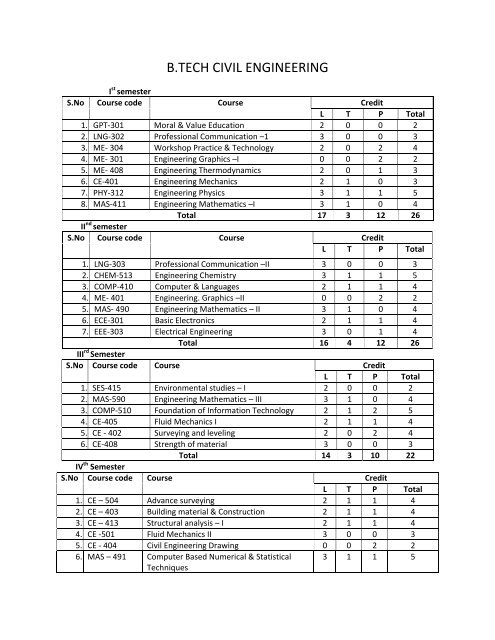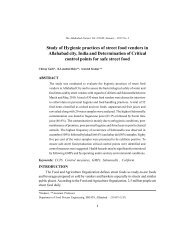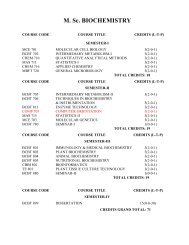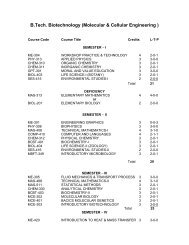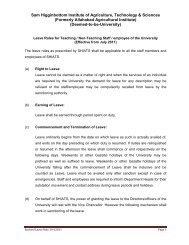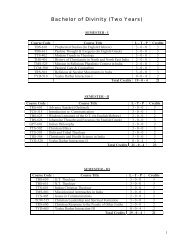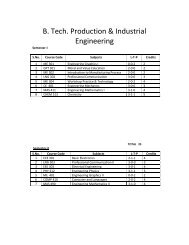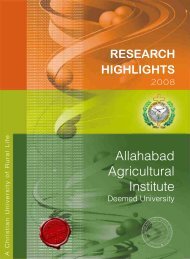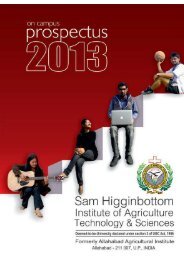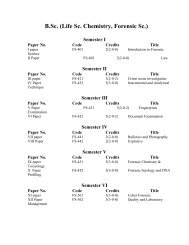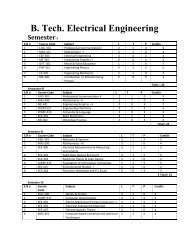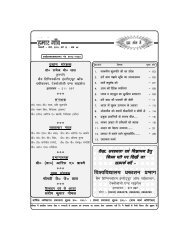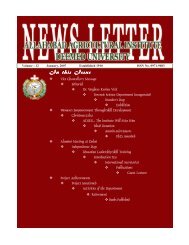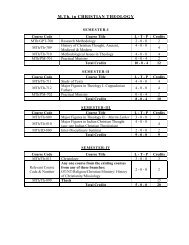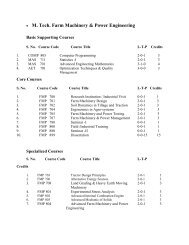B.TECH CIVIL ENGINEERING - Shiats.edu.in
B.TECH CIVIL ENGINEERING - Shiats.edu.in
B.TECH CIVIL ENGINEERING - Shiats.edu.in
You also want an ePaper? Increase the reach of your titles
YUMPU automatically turns print PDFs into web optimized ePapers that Google loves.
B.<strong>TECH</strong> <strong>CIVIL</strong> <strong>ENGINEERING</strong>I st semesterS.No Course code Course CreditL T P Total1. GPT‐301 Moral & Value Education 2 0 0 22. LNG‐302 Professional Communication –1 3 0 0 33. ME‐ 304 Workshop Practice & Technology 2 0 2 44. ME‐ 301 Eng<strong>in</strong>eer<strong>in</strong>g Graphics –I 0 0 2 25. ME‐ 408 Eng<strong>in</strong>eer<strong>in</strong>g Thermodynamics 2 0 1 36. CE‐401 Eng<strong>in</strong>eer<strong>in</strong>g Mechanics 2 1 0 37. PHY‐312 Eng<strong>in</strong>eer<strong>in</strong>g Physics 3 1 1 58. MAS‐411 Eng<strong>in</strong>eer<strong>in</strong>g Mathematics –I 3 1 0 4Total 17 3 12 26II nd semesterS.No Course code CourseCreditL T P Total1. LNG‐303 Professional Communication –II 3 0 0 32. CHEM‐513 Eng<strong>in</strong>eer<strong>in</strong>g Chemistry 3 1 1 53. COMP‐410 Computer & Languages 2 1 1 44. ME‐ 401 Eng<strong>in</strong>eer<strong>in</strong>g. Graphics –II 0 0 2 25. MAS‐ 490 Eng<strong>in</strong>eer<strong>in</strong>g Mathematics – II 3 1 0 46. ECE‐301 Basic Electronics 2 1 1 47. EEE‐303 Electrical Eng<strong>in</strong>eer<strong>in</strong>g 3 0 1 4Total 16 4 12 26III rd SemesterS.No Course code CourseCreditL T P Total1. SES‐415 Environmental studies – I 2 0 0 22. MAS‐590 Eng<strong>in</strong>eer<strong>in</strong>g Mathematics – III 3 1 0 43. COMP‐510 Foundation of Information Technology 2 1 2 54. CE‐405 Fluid Mechanics I 2 1 1 45. CE ‐ 402 Survey<strong>in</strong>g and level<strong>in</strong>g 2 0 2 46. CE‐408 Strength of material 3 0 0 3Total 14 3 10 22IV th SemesterS.No Course code CourseCreditL T P Total1. CE – 504 Advance survey<strong>in</strong>g 2 1 1 42. CE – 403 Build<strong>in</strong>g material & Construction 2 1 1 43. CE – 413 Structural analysis – I 2 1 1 44. CE ‐501 Fluid Mechanics II 3 0 0 35. CE ‐ 404 Civil Eng<strong>in</strong>eer<strong>in</strong>g Draw<strong>in</strong>g 0 0 2 26. MAS – 491 Computer Based Numerical & StatisticalTechniques3 1 1 5
7. SES – 416 Environmental Studies ‐ II 2 0 0 28. SWLE‐403 Eng<strong>in</strong>eer<strong>in</strong>g Hydrology 3 0 0 3Total 17 4 12 27S.NoV th SemesterCourse code CourseCreditL T P Total1. CE – 505 Structural analysis – II 2 1 1 42. CE – 414 Concrete structure – I 2 1 1 43.Transportation Eng<strong>in</strong>eer<strong>in</strong>g – I 2 1 1 4CE – 4154. CE – 416 Geotech Eng<strong>in</strong>eer<strong>in</strong>g ‐ I 2 1 0 35. CE ‐ 511 Hydraulic Mach<strong>in</strong>es 2 1 1 46. SWLE‐508 Ground Water Eng<strong>in</strong>eer<strong>in</strong>g 3 0 0 37. BAM ‐ 315 Elements of economics & pr<strong>in</strong>cipals3 1 0 4management scienceTotal 16 6 8 26VI th SemesterS.No Course code CourseCreditL T P Total1. CE – 506 Estimation and cost<strong>in</strong>g management 2 1 0 32. CE – 507 Concrete structure – II 2 1 1 43.Transportation Eng<strong>in</strong>eer<strong>in</strong>g – II 2 1 0 3CE – 5084. CE – 608 Eng<strong>in</strong>eer<strong>in</strong>g Geology 2 1 1 45. CE – 509 Geotechnical Eng<strong>in</strong>eer<strong>in</strong>g – II 2 1 1 46. CE – 510 Environmental Eng<strong>in</strong>eer<strong>in</strong>g ‐ I 3 1 0 47. CE – 503 Survey camp 0 0 2 28. SWLE – 408 Water Resources Engg – I 2 1 0 3Total 15 7 10 27VII th SemesterS.No Course code CourseCreditL T P Total1. CE – 601 CAD <strong>in</strong> Structures 2 0 2 42. CE – 603 Environmental Eng<strong>in</strong>eer<strong>in</strong>g ‐ II 2 1 1 43.Design of Steel Structure 3 1 0 4CE – 6054. CE – 606 Project plann<strong>in</strong>g and construction management 3 1 0 45. SWLE‐502 Irrigation Eng<strong>in</strong>eer<strong>in</strong>g 3 0 1 46. CE – 699A Project (Project Formulation) 0 0 2 27. CE – 580 Sem<strong>in</strong>ar ‐ I 0 0 1 18. CE – 500 Tra<strong>in</strong><strong>in</strong>g 0 0 1 1*Total 12 3 18 24VIII th SemesterS.No Course code CourseCreditL T P Total1. CE ‐ 680 Sem<strong>in</strong>ar – II 0 0 1 12. CE – 650‐679 Elective – I 3 0 0 3
Speech Drills ‐ Us<strong>in</strong>g the language laboratory to develop Speak<strong>in</strong>g Communication Skills.Word Accent: Production of correct accentual patterns <strong>in</strong>volv<strong>in</strong>g two and three syllabi words.Rhythm: Stress‐tone rhythm <strong>in</strong> sentences.Intonation: Ris<strong>in</strong>g Tone and Talk<strong>in</strong>g Tone Ear Tra<strong>in</strong><strong>in</strong>g and Production Tests.References:1. Close R.A.: A University Grammar of English Workbook.2. Longman, London, 1998.3. Jones, Daniel: English Pronounc<strong>in</strong>g Dictionary, ELBS, and London, 1999.4. Sharma S.D: A Textbook of Spoken and Written English, Vikas, 1994.5. Alvarez, Joseph A.: The Elements of Technical Writ<strong>in</strong>g, New York: Harcourt, 1998.6. 5.Bansal, R.K.: Spoken English For India, Orient Longman, 1993Workshop PracticeCourse Code ME‐310 Credit 4[2‐0‐2]1.IntroductionClassification of manufactur<strong>in</strong>g processes, Primary shap<strong>in</strong>g process, Mach<strong>in</strong><strong>in</strong>g processes, Jo<strong>in</strong><strong>in</strong>gprocesses, Surface f<strong>in</strong>ish<strong>in</strong>g processes, Plant & Shop layout, Industrial Safety.2. Properties of MetalsStrength, Elasticity, Stiffness, Plasticity, Malleability, Ductility, Brittleness, Toughness, Hardness, Impactstrength, Fatigue, Creep.3. Classification of MetalsWrought iron, Cast iron, Grey cast iron, White cast iron, Nodular cast iron, Alloy cast iron, Steel, Mildsteel, Medium Carbon steel, High carbon steel and its application. Effect of alloy<strong>in</strong>g elements on steel,Special alloy steels, e.g. sta<strong>in</strong>less steel, high speed steel, cutt<strong>in</strong>g alloys.4. Non‐ferrous MetalsAlum<strong>in</strong>ium, Copper, Z<strong>in</strong>c, Lead, T<strong>in</strong>, Nickel, Non‐ferrous alloys, Brass, Bronze.5. Carpentry ShopIntroduction, Selection of timber, Season<strong>in</strong>g of Timber, Common defects <strong>in</strong> timber, Preservation oftimber, Auxiliary materials used <strong>in</strong> carpentry, Veerners and Veneer<strong>in</strong>g, Plywood, Wood work<strong>in</strong>g handtools, Mark<strong>in</strong>g and measur<strong>in</strong>g tools, Hold<strong>in</strong>g & Support<strong>in</strong>g tools, Cutt<strong>in</strong>g tools, Saws, chisel, Planers,Bor<strong>in</strong>g tools, Wood work<strong>in</strong>g processes, Jo<strong>in</strong>ery work classification of jo<strong>in</strong>ts.6. Bench Work<strong>in</strong>g & Fitt<strong>in</strong>g ShopIntroduction, Vices, Vice blocks, Surface plates, Trisquare, Bevel square, Comb<strong>in</strong>ation set files, Chisel,Hacksaw, Surface gauge, Universal surface gauge, Punches, Calipers, Dividers, Pliers, Spanners, Drills taps.Die and die stock. Screw pitch gauge, Wire gauge, Dial <strong>in</strong>dicator, Bench work<strong>in</strong>g processes.7. Weld<strong>in</strong>g ShopConcept of weld<strong>in</strong>g, Resistance weld<strong>in</strong>g, Spot weld<strong>in</strong>g resistance butt and flash weld<strong>in</strong>g, Resistanceprojection weld<strong>in</strong>g and seam weld<strong>in</strong>g, Electric arc weld<strong>in</strong>g, Gas weld<strong>in</strong>g (Oxy‐Acetylene weld<strong>in</strong>g),Equipments and process, weld<strong>in</strong>g jo<strong>in</strong>ts and positions of weld<strong>in</strong>g.8. Sheet Metal ShopIntroduction, Metals used <strong>in</strong> sheet metal shop hand tools, Sheet metal operations.List of practical:1. To make a T‐lap carpentry jo<strong>in</strong>t.2. To make the wooden block of given size with the help of plann<strong>in</strong>g ‐ to make a square slot, tomake a semi circular arc.
Number systems, conversion of bases, Boolean algebra, Logic Gates, concept of universal gate,canonical forms, and m<strong>in</strong>imization us<strong>in</strong>g K‐map.Electronic Instruments:Multimeter, CRO and its Applications.References:1. Boylestad & Nashelsky/Electronic Devices & Circuits/ PHI.2. Morris Mano/Digital Computer Design/ PHI.3. Milliman, J. Halkias/Integrated Electronics/TMH.4. Malv<strong>in</strong>o & Leach/Digital Pr<strong>in</strong>ciples & Application/List of Experiments:1. Study of Diode characteristics.2. Study of Common Base Transistor characteristics.3. Study of Common Emitter Transistor characteristics.4. Study of Half Wave Rectifier with effect of Capacitor and also calculate the ripple factor.5. Study of Full‐ Wave Rectifier with effect of Capacitor and also calculate the ripple factor.6. Study of Various Logic Gates.7. Study of Clipp<strong>in</strong>g and clamp<strong>in</strong>g Circuits.8. Study of C.R.O., Function generator, Multimeter.Electrical Eng<strong>in</strong>eer<strong>in</strong>gCourse Code EEE‐304 Credit 4[3‐0‐1]S<strong>in</strong>usoidal Steady State Circuit Analysis:Voltage, Current, S<strong>in</strong>usoidal & Phasor representation.1‐Phase A.C. Circuit‐behavior of resistance,Inductance and Capacitance and their comb<strong>in</strong>ations, impedance, concept of power, power factor, series& parallel resonance‐bandwidth and quality factor.Network Theory:Introduction to basic physical laws, Network theory: Superposition, Theven<strong>in</strong>, Norton, Maximum Powertransfer theorems, Star‐delta transformation, Circuit theory Concepts: Mesh and Nodal analysis.Three Phase Supply:Star/delta connections, l<strong>in</strong>e and phase voltage/current relations, Three‐phase power and itsmeasurement.Basic Instruments:Instruments for measurement of voltage, Current, power and energy: Construction, pr<strong>in</strong>ciple andapplication.Magnetic Circuit and Transformer:Magnetic circuit concept, theory and work<strong>in</strong>g pr<strong>in</strong>ciple of s<strong>in</strong>gle‐phase transformer.Rotat<strong>in</strong>g Mach<strong>in</strong>es:Pr<strong>in</strong>ciples of energy conversion, Basic concepts of rotat<strong>in</strong>g mach<strong>in</strong>es, DC mach<strong>in</strong>es, Different types andtheir characteristics & applications. Elementary idea of operation of synchronous and <strong>in</strong>ductionmach<strong>in</strong>es. S<strong>in</strong>gle‐phase <strong>in</strong>duction & stepper motors, Applications.Power Systems:Introduction, Elements, L<strong>in</strong>e diagram, Supply systems, Power factor improvement.Reference:1. V. Del Toro/ Pr<strong>in</strong>ciples of Electrical Eng<strong>in</strong>eer<strong>in</strong>g/ PHI.2. W.H Hayt & J.E Kennedy/ Eng<strong>in</strong>eer<strong>in</strong>g Circuit Analysis/ McGraw Hill.3. I.J Nagrath/ Basic Electrical Eng<strong>in</strong>eer<strong>in</strong>g/ Tata McGraw Hill.4. A.E Fitzgerald/ Electronic Instruments & Measurement Techniques/ PHI.5. Higg<strong>in</strong>botham L.Grabel/Basic Electrical Eng<strong>in</strong>eer<strong>in</strong>g/ McGraw Hill.List of Practical’s:A m<strong>in</strong>imum of 10 experiments from the follow<strong>in</strong>g:
1. Verification of Theven<strong>in</strong>’s Theorem.2. Verification of Superposition Theorem.3. Verification of Norton’s Theorem4. Verification of Kirchoff’s Law.5. To measure the value of impedance and power factor <strong>in</strong> RLC series A.C. circuit.6. To measure the value of impedance and power factor <strong>in</strong> RLC parallel A.C.7. circuit.8. To study resonance by frequency variation <strong>in</strong> series RLC circuit.9. To calibrate the given energy meter with the help of a standard wattmeter.10. To f<strong>in</strong>d the relation between l<strong>in</strong>e current and phase current and l<strong>in</strong>e voltage and phase voltage <strong>in</strong>Star – Delta connections.11. To perform open circuit and short circuit test and draw the equivalent circuit of a s<strong>in</strong>gle‐phasetransformer.12. To measure three phase power by two‐wattmeter method.13. To draw the magnetiz<strong>in</strong>g characteristic of a s<strong>in</strong>gle‐phase transformer.Additional experiments may be added based on contents of syllabi.Eng<strong>in</strong>eer<strong>in</strong>g PhysicsCourse Code PHY‐312 Credit 5[3‐1‐1]Special Theory of Relativity:Michelson Morley experiment, Inertial frames of reference, Postulates of special theory of relativity,Lorentz transformation equation of space and time, length contraction, time dilaton, addition ofvelocities, variation of mass with velocity, mass‐energy equivalence.Optics :Interference: Coherent sources, Conditions of <strong>in</strong>terference, Fresnel’s bi‐prism experiment,displacement of fr<strong>in</strong>ges, <strong>in</strong>terference <strong>in</strong> th<strong>in</strong> films, wedge shaped film, Newton’s r<strong>in</strong>gs.Diffraction: S<strong>in</strong>gle slit and double slit diffraction, diffraction grat<strong>in</strong>g, Reyleigh’s criterion of limit ofresolution, resolv<strong>in</strong>g power of telescope, microscope and grat<strong>in</strong>g.Polarization: Polarization of light, Pictorial representation of polarized light, Brewster’s law, Malus law,Phenomena of double refraction, Geometry of calcite crystal, Optical activity, Specific rotation,Polarimeter.Fields:Scalar and vector fields, Gradient of a scalar field, divergence and curl of a vector field, l<strong>in</strong>e <strong>in</strong>tegral,conservative vector field, Gauss’ Divergence theorem, Stoke’s theorem.Electrostatics:Gauss’ law and its applications, Poisson and Laplace equations. Maxwell’s equations, Basic Concepts ofElectromagnetic waves and its solution <strong>in</strong> free space.Magnetic Properties of Materials:Para, dia, ferro, antiferro and ferro‐magnetic materials, hysteresis, Methods of plott<strong>in</strong>g hysteresis curveof a ferro‐magnetic material and their uses, magnetic circuits.X‐Rays:Orig<strong>in</strong> of X‐rays, Cont<strong>in</strong>uous and characteristic X‐Ray spectra, Moseley’s law, Absorption of X‐rays,Diffraction of X‐rays, Bragg’s law, Bragg’s spectrometer, Practical application of X‐rays, Compton effect.Quantum Theory:Wave particle duality, De Broglie concept of matter waves, Davisson and Germer experiment,Heissenberg’s uncerta<strong>in</strong>ty pr<strong>in</strong>ciple, Schrod<strong>in</strong>ger wave equation and its applications.
Laser:Spontaneous and stimulated emission of radiation, E<strong>in</strong>ste<strong>in</strong>’s coefficients, Ma<strong>in</strong> components of a laser,types of lasers and their applications.References:1. Arthur Beiser: Concepts Of Modern Physics, TMH.2. Subramanyam & Brij Lal: A Text Book of Optics, S. Chand & Co.3. K.K. Tiwari: Electricity & Magnetism, S. Chand & Co.4. Brij Lal & Subramanyam: Electricity & Magnetism.5. Wehr, Richardo & Adair: Physics of the Atom.List Of Experiments (Any Ten)1. To determ<strong>in</strong>e the wavelength of monochromatic light by Newton’s r<strong>in</strong>g.2. To determ<strong>in</strong>e the wavelength of monochromatic light with the help of Fresnel’s biprism.3. To determ<strong>in</strong>e the focal length of two lenses by nodal slide and locate the position of card<strong>in</strong>alpo<strong>in</strong>ts.4. To determ<strong>in</strong>e the specific rotation of cane sugar solution us<strong>in</strong>g half shade polarimeter.5. To determ<strong>in</strong>e the wavelength of spectral l<strong>in</strong>es us<strong>in</strong>g plane transmission grat<strong>in</strong>g.6. To determ<strong>in</strong>e the specific resistance of the material of given wire us<strong>in</strong>g Carey Foster’s bridge.7. To determ<strong>in</strong>e the variation of magnetic field along the axis of a current carry<strong>in</strong>g coil and then toestimate the radius of the coil.8. To verify Stefan’s Law by electrical method.9. To calibrate the given ammeter and voltmeter.10. To study the Hall Effect and determ<strong>in</strong>e Hall coefficient, carrier density and mobility of a givensemiconductor material us<strong>in</strong>g Hall Effect set up.11. To determ<strong>in</strong>e the energy band gap of a given semiconductor material.12. To determ<strong>in</strong>e E.C.E of copper us<strong>in</strong>g Tangent or Helmholtz galvanometer.13. To draw hysteresis curve of a given sample of ferromagnetic material and from this to determ<strong>in</strong>emagnetic susceptibility and permeability of the given specimen.14. To determ<strong>in</strong>e the ballistic constant of a ballistic galvanometer.15. To determ<strong>in</strong>e the viscosity of a liquid.16. To determ<strong>in</strong>e refractive <strong>in</strong>dex of the material of prism us<strong>in</strong>g spectrometer.Eng<strong>in</strong>eer<strong>in</strong>g Mathematics –ICourse Code MAS‐411 Credit 4[3‐1‐0]Matrices :Elementary row and column transformations, L<strong>in</strong>ear dependence, Rank of matrix,Consistency of system of l<strong>in</strong>ear equations and solution of l<strong>in</strong>ear equations, Characteristic equation,and Caley‐Hamilton theorem, Eigen values and Eigen vectors, Diagonalisation, Complex and unitarymatrices.Differential Calculus‐I:Leibnitz theorem, Partial differentiation, Euler’s theorem, Asymptotes, Curvetrac<strong>in</strong>g, Change of Variables, expansion of functions of one and several variables. Cyl<strong>in</strong>drical andspherical coord<strong>in</strong>ate systemsDifferential Calculus‐II: Jacobian, Approximation of errors, Extrema of function of several variables,Lagrange’s method of multipliers (simple applications).Multiple <strong>in</strong>tegrals: Double and triple <strong>in</strong>tegrals, change of order, change of variables, Gamma & Betafunctions, application to area, volume, Disrichlet’s <strong>in</strong>tegral and its applications.Vector Calculus: Po<strong>in</strong>t functions, Gradient, divergence and curl of a vector and their physical<strong>in</strong>terpretations, l<strong>in</strong>e, surface & volume <strong>in</strong>tegrals, Gauss divergence theorem and Greens & Stokestheorem.
References:1. Shanti Narayan: A Text Book of matrices, S.Chand & Co.2. Thomas/F<strong>in</strong>ney: Calculus and Analytic Geometry, Narosa Pub. House.3. J. N. Kapur: Mathematical Statistis, S. Chand &Co.4. C. Prasad: Mathematics for Eng<strong>in</strong>eers, Prasad Mudranalaya.5. B.S. Grewal: Higher Eng<strong>in</strong>eer<strong>in</strong>g Mathematics, Khanna Publishers.6. Jaggi & Mathur : Advanced Eng<strong>in</strong>eer<strong>in</strong>g Mathematics, Khanna Publishers.7. Piskunov, N.: Differential & Integral Calculus, Moscow Peace Pub.8. H.K. Das, Eng<strong>in</strong>eer<strong>in</strong>g Mathematics.9. Vijai Shankar Verma & Sanjeev Kumar, Eng<strong>in</strong>eer<strong>in</strong>g Mathematics.10.Rakesh Dubey, Eng<strong>in</strong>eer<strong>in</strong>g MathematicsProfessional Communication –IICourse Code LNG‐303 Credit 3[3‐0‐0]Technical Written Communication:Nature, orig<strong>in</strong> and development of technical written communication, Salient Features, Differencebetween technical writ<strong>in</strong>g and general writ<strong>in</strong>g.Pre‐requisites of Scientific and Technical Communication:Fragment sentences, Parallel comparisons, Elements of a series, Squ<strong>in</strong>t<strong>in</strong>g construction and split<strong>in</strong>f<strong>in</strong>itive, Modifiers, connectives, antecedents and clause subord<strong>in</strong>ation, Dangl<strong>in</strong>g participles andgerunds.Ellipsis, Coherence, Unity, Chronological method, spatial method, <strong>in</strong>ductive method, l<strong>in</strong>ear method,d<strong>edu</strong>ctive method, <strong>in</strong>terrupted method.Bus<strong>in</strong>ess Correspondence:General pr<strong>in</strong>ciples of bus<strong>in</strong>ess correspondence.Ramifications of bus<strong>in</strong>ess letters.Letters giv<strong>in</strong>g <strong>in</strong>structions, <strong>in</strong>quiries and answers to enquiries, compla<strong>in</strong>ts and adjustments, lettersurg<strong>in</strong>g action, employment letters, application and resumes.Proposal Writ<strong>in</strong>g: Proposal: Def<strong>in</strong>itions and k<strong>in</strong>ds, Division of format proposals (front matter, titlepage, summary/ abstract, Table of contents etc.)Statement of request, body‐ statement of problem, background, scope, methodology, Advantagesand disadvantages.Writ<strong>in</strong>g Scientific and Semi‐technical Articles:Source material, topic sentence, literature review. Tables, figures, footnotes, bibliography.Study of Scientific and General Texts:Prescribed text books for detailed studyArora, V.N (et. al.), Improve your writ<strong>in</strong>g (Delhi: Oxford University Press, 1981.Lesson No. 1.2, 1.6, 2.4, 3.5, 4.1, 4.3, 5.1, 5.4, 6.2.For extended Read<strong>in</strong>g (any one of the follow<strong>in</strong>g)Orwell George, N<strong>in</strong>eteen Eighty Four (New York: Pengu<strong>in</strong>, 1984)Hem<strong>in</strong>gway, Ernest, The old man and the Sea, (Oxford: 1990)Listen<strong>in</strong>g Comprehension:(a) Ear‐tra<strong>in</strong><strong>in</strong>g.(b) Uses of latest scientific techniques (AVR Comprehension tra<strong>in</strong>er,SRA Comprehension tra<strong>in</strong>er, SRA Comprehension Accelerator, AVR Comprehension Reteometer.)
Read<strong>in</strong>g Comprehension:(a) Scann<strong>in</strong>g method.(b) Skimm<strong>in</strong>g method.Phonetic Transcription:Stresses and Intonation:References1. Sherman, Theodore A. (et al) Modern Technical Writ<strong>in</strong>g, New Jersey, Prentice Hall, 1991.2. Legget, Glenn (et al) Essentials of grammar and composition, Macmillan, Delhi 1994.3. Strunk, Jr. William (et al), The elements of style, Macmillan, 1987.4. Sharma, S.D A Text Book of Scientific and Technical Writ<strong>in</strong>g, Vikas, Delhi, 1990.ChemistryCourse Code CHEM‐513 Credit 5[3‐1‐1]General Chemistry:Advanced Theory of Chemical Bond<strong>in</strong>g: Valence bond and molecular orbital theory. Structure of NH3,H2O, SO3, PCl5, XeO2 molecules. Theories of bond<strong>in</strong>g <strong>in</strong> metals and semiconductors, n‐type and p‐type semi‐conductors, Imperfections <strong>in</strong> materials. Born‐Haber cycle, Bragg’s conditions.Physical Chemistry:Equilibrium on Reactivity: Bronsted and Lewis Acids, pH, pka, pkb Scale, Buffer solution.Stereochemistry of organic compounds, Co‐ord<strong>in</strong>ation chemistry, Nomenclature, Valence Bond andcrystal field theory.Chemical K<strong>in</strong>etics & Catalysis: Rate law, Order of reactions, Parallel and reversible reactions, Catalysis,Homogeneous and heterogeneous catalysis, Characteristics of catalytic reaction, Catalytic promotersand poi‐sons, Auto catalysis and negative catalysis, Intermediate compound formation theory andabsorption theory.Environment Chemistry:Atmospheric Chemistry & Air Pollution: Environment and Ecology, Environmental segments, Structureand composition of atmosphere, Radiation Balance of Earth and Green House Effect, Formation anddepletion of Ozone layer, Chemical and photochemical reactions of various species <strong>in</strong> atmosphere,Air pollution – sources, reactions and s<strong>in</strong>ks for pollutants, Acid ra<strong>in</strong>s and Smog formation. Pollutioncontrol methods.Corrosion and Lubrication: Introduction, causes of corrosion, Theories of corrosion, Factors<strong>in</strong>fluenc<strong>in</strong>g Corrosion, Corrosion <strong>in</strong>hibitors, passivity, Types of corrosion, Protection from corrosionand protective coat<strong>in</strong>gs. Theory, Classification and mechanism of Lubrication.Applied Chemistry:Water and Waste Water Chemistry: Introduction, Hardness of water, characteristics imparted byimpurities, Analysis of contam<strong>in</strong>ants, Treatment of Water by Zeolite, L‐S process, Boiler feed water,Waste water treatment.Chemistry of Eng<strong>in</strong>eer<strong>in</strong>g Materials:Fuels & Combustion: Classification of fuels, Non conventional Energy, Biogas, Biomass and solarenergy. Calorific value‐ gross and net, characteristics of good fuel, Determ<strong>in</strong>ation of calorific value,Solid fuels, Analysis of coal, Liquid fuels.Instrumentation: IR, UV, NMR, MASS AND ASS.Industrial Chemistry:Polymer Chemistry: Classification of Polymers, Includ<strong>in</strong>g Biopolymers condensation and additionpolymers and their applications. IndustrialApplication and mechanism of chemical reaction, Beckman, Hoffman, Reimer Tiemann, Cunnizzaro,Diels Alder and Skraup synthesis.
References:1. Puri and Sharma/Pr<strong>in</strong>ciples of Physical Chemistry.2. Manas Chandra/Atomic Structure and Chemical Bond.3. Bahl and Tuli /Eng<strong>in</strong>eer<strong>in</strong>g Chemistry.4. Ja<strong>in</strong> and Ja<strong>in</strong>/A Text‐Book of Eng<strong>in</strong>eer<strong>in</strong>g Chemistry5. S.S Dara/Environmental Chemistry and Pollution Control.6. S.S Dara /Environmental Chemistry.7. A.K De/Environmental Chemistry.List of Experiments: (Any Ten):1. To determ<strong>in</strong>e the percentage of available chlor<strong>in</strong>e <strong>in</strong> the supplied sample of Bleach<strong>in</strong>g powder.2. To determ<strong>in</strong>e the Ferrous content <strong>in</strong> the supplied sample of iron ore by titrimetric analysisaga<strong>in</strong>st standard K∧Cr∧ solution us<strong>in</strong>g K, Fe(CN)g as external <strong>in</strong>dicator.3. To determ<strong>in</strong>e the chloride content <strong>in</strong> supplied water sample us<strong>in</strong>g Mohr’s method.4. To determ<strong>in</strong>e the constituents and amount of alkal<strong>in</strong>ity of the supplied water sample.5. To determ<strong>in</strong>e the Temporary and Permanent hardness of water sample by Coplexometry.6. To f<strong>in</strong>d the Chemical Oxygen Demand of a waste water sample us<strong>in</strong>g Potassium dichromate.7. To determ<strong>in</strong>e iron concentration <strong>in</strong> the sample of water by spectrophotometric method.8. To f<strong>in</strong>d out the Velocity constant for the <strong>in</strong>version of cane sugar <strong>in</strong> acidic medium and to showthat <strong>in</strong>version follows the first order k<strong>in</strong>etics.9. To determ<strong>in</strong>e the Molecular weight of a polystyrene sample by us<strong>in</strong>g Viscometer method.10. To determ<strong>in</strong>e pH of a solution us<strong>in</strong>g a pH‐meter and titration of such a solution pH‐metrically.11. To determ<strong>in</strong>e the calorific value of a fuel sample by us<strong>in</strong>g a Bomb Calorimeter.12. Analysis of a coal sample by proximate analysis method.13. References:14. Vogel’s Qualitative Chemical Analysis: Ed. By Jaffery Bassette et. al. (ELBS).15. Applied Chemistry‐ Theory and Practice, 2nd Ed. By Virmani and Narula (New Age InternationalPub.).16. Experiments <strong>in</strong> Eng<strong>in</strong>eer<strong>in</strong>g Chemistry, Ed. By Masood Alam (Maktaba Jamia Limited).Computer & LanguagesCourse Code COMP‐410 Credit 4[2‐1‐1]Computer hardware components and their functions .Basic operat<strong>in</strong>g system conceptsMS‐DOS and gett<strong>in</strong>g to know DOS commandsFamiliariz<strong>in</strong>g with WINDOWS environmentGett<strong>in</strong>g started with UNIXFiles and Directories and their use <strong>in</strong> different Operat<strong>in</strong>g System EnvironmentsGett<strong>in</strong>g to know different editors like edit & viIntroduction to InternetGett<strong>in</strong>g familiar with Web Browsers like Netscape Navigator & Internet ExplorerSend<strong>in</strong>g & receiv<strong>in</strong>g mail over InternetIntroduction to PINE and /or ELMNeed of programm<strong>in</strong>g languages.Language translators.Introduction to “C” languageData types operators and expressions.Conditional & loop<strong>in</strong>g statements.
Function & Arrays.Introduction to Po<strong>in</strong>ters & Structures.References:1. DOS the complete reference by Kris Jamsa, Tata‐ McGraw Hill Publication.2. UNIX POWER TOOLS by J.Peek Tim O’reilly & M. Locekides, BPB Publication.3. The ‘C’ Programm<strong>in</strong>g Language by B.W Kernighan & D.M Ritchie, Prentice Hall of India.4. Us<strong>in</strong>g LINUX‐ Latest Edition by Jade Tackett & David Ganter, Prentice Hall of India.List of Experiments:1. Basic Internal and External DOS Commands.2. Write a simple batch program.3. Giv<strong>in</strong>g exposure to W<strong>in</strong>dows environment.4. File and program management <strong>in</strong> w<strong>in</strong>dows.5. Practice of basic UNIX commands.6. Write simple shell script.7. Introduction to word process<strong>in</strong>g.8. Exposure to advance feature supported by some editors.9. Net Surf<strong>in</strong>g.10. Creation and check<strong>in</strong>g of E‐mail account.11. Write C program to demonstrate each of the follow<strong>in</strong>g:12. Conditional statements.13. Loop<strong>in</strong>g statements.14. User def<strong>in</strong>ed functions.15. Arrays.16. Po<strong>in</strong>ters and structures.17. Familiariz<strong>in</strong>g mail account us<strong>in</strong>g PINE, delet<strong>in</strong>g, creat<strong>in</strong>g folder/mail‐messages, add<strong>in</strong>g signature,creat<strong>in</strong>g director of addresses.Note: List may be modified accord<strong>in</strong>g to new software available.Mechanical Eng<strong>in</strong>eer<strong>in</strong>gCourse Code ME‐330 Credit 5[3‐1‐1]Thermodynamics:Fundamental Concepts and Def<strong>in</strong>itions:Introduction to SI units, Def<strong>in</strong>ition of thermodynamics, System, Surround<strong>in</strong>g and universe, Phase,Concept cont<strong>in</strong>uum, Macroscopic and Microscopic po<strong>in</strong>t of view, Density, Sp. Volume, Pressure,Thermodynamic equilibrium, Property, State, Path, Process, Cyclic process, Quasi‐static process,Reversible and irreversible process, Energy and its forms, Work and head, NTP and STP.Ideal and Real Gases:Concept of ideal gas, characteristic equation of gas. Universal and characteristic gas constant. Enthalpyand specific heat, Deviation of real gas from ideal gas, compressibility factor and the Van der Waall’sequation of state for real gas.Laws of ThermodynamicsZeroth Law: Concept of temperature. Equality of Temperature, Zeroth law, Pr<strong>in</strong>ciple of thermometryand temperature scale.First Law: First Law of thermodynamics. Concept processes, Flow processes and control volume, Flowwork, Steady flow energy equation, Mechanical work <strong>in</strong> a steady flow process, Throttl<strong>in</strong>g process,Application of first law to open systems.
Second Law: Essence of second law. Thermal reservoir. Heat Eng<strong>in</strong>es and thermal efficiency, COP ofheat pump and refrigerator. Def<strong>in</strong>ition of available and unavailable energy, Statement of second law,Carnot cycle, Carnot’s theorem, Clausius <strong>in</strong>equality, Concept of Entropy, Entropy change for ideal gases.Properties of steam:Generation of steam at constant pressure. Various states of water, Properties of steam, Use of propertydiagram, Process of vapour <strong>in</strong> closed and open system, Determ<strong>in</strong>ation of dryness fraction of steam byseparat<strong>in</strong>g and throttl<strong>in</strong>g Calorimeter, Rank<strong>in</strong> cycle.Thermodynamic Cycles:Def<strong>in</strong>itions of bore, Stroke clearance ratio, Compression ratio, Def<strong>in</strong>ition and calculation of meaneffective pressure from the cycle work (proof not required), Indicated pressure, Air standard cycles(Otto and Diesel cycles), Pr<strong>in</strong>ciple of work<strong>in</strong>g and description of two and four stroke SI and CI eng<strong>in</strong>es.Strength Of Materials:Simple Stresses and Stra<strong>in</strong>sStress‐ tensile and compressive, stra<strong>in</strong>, stra<strong>in</strong> energy, stress‐stra<strong>in</strong> diagram, ductile and brittle material,elastic constants, impact load<strong>in</strong>g, vary<strong>in</strong>g cross‐section and load, temperature stresses, shear stress,complimentary shear stress, shear stra<strong>in</strong>, stra<strong>in</strong> energy.Compound Stress and Stra<strong>in</strong>sState of stress at a po<strong>in</strong>t, Oblique stress, simple tension, pure shear, general two‐dimensional stresssystem, pr<strong>in</strong>ciple planes, pr<strong>in</strong>ciple stresses and stra<strong>in</strong>s, Mohr’s stress circle, Poisson’s ratio, Maximumshear stress.Bend<strong>in</strong>g StressPure bend<strong>in</strong>g, Moment of <strong>in</strong>ertia, Section modulus, Bend<strong>in</strong>g stresses, comb<strong>in</strong>ed bend<strong>in</strong>g and directstress, beam of uniform strength, middle third and Middle quarter rules for rectangular and circularsections.TorsionCircular shafts, Torsional shear stress, Stra<strong>in</strong> energy <strong>in</strong> torsion, Shafts under vary<strong>in</strong>g torque, Compoundshafts, Comb<strong>in</strong>ed bend<strong>in</strong>g and twist<strong>in</strong>g.References:Van Wylen G.J & Sonnlog R.E: Fundamentals of classical thermodynamics, John Wiley & Sons, Inc. NY.Wark Wenneth: Thermodynamics (2nd edition), McGraw Hill book Co. NY)Yadav R.: Thermodynamics and Heat Eng<strong>in</strong>es, Vol. I & II (SI Edition) Central Publish<strong>in</strong>g House, Allahabad.Yadav R.: Steam and Gas Turb<strong>in</strong>es.Kshitish Chandra Pal: Heat Power, Orient Longman Limited, 17, Chittranjan Avenue, Calcutta.S. Rao, B.B. Parulekar: ‘Energy Technology’, Khanna Pub, New Delhi.G.H. Ryder:” Strength of Materials”.List of Experiments:1. Study of boiler models‐ Babcock Wilcox, Lancashire and Locomotive.2. Study of Steam eng<strong>in</strong>e and steam turb<strong>in</strong>e models.3. Study of 2‐stroke and 4‐stroke I.C.E models.4. Study of Fiat eng<strong>in</strong>e and/or Diesel eng<strong>in</strong>e prototype.5. Study of vapour compression Refrigeration unit tutor/refrigerator.6. Study of a w<strong>in</strong>dow type air conditioner.7. To conduct the tensile test on a UTM and determ<strong>in</strong>e ultimate Tensile strength, percentageelongation for a steel specimen.8. To conduct the compression test and determ<strong>in</strong>e the ultimate compressive strength for aspecimenEng<strong>in</strong>eer<strong>in</strong>g Mechanics
Riveted Jo<strong>in</strong>ts:Introduction, Rivets and rivet<strong>in</strong>g, Rivet heads, Classification of riveted jo<strong>in</strong>ts.Assembly Draw<strong>in</strong>g:Introduction, Eng<strong>in</strong>e parts, Stuff<strong>in</strong>g box etc.Free Hand Sketch<strong>in</strong>g:Need for free hand sketch<strong>in</strong>g, Free hand sketch<strong>in</strong>g of some threaded fasteners andsimple mach<strong>in</strong>e components.References:N. Siddeshwar, P. Kannaiah, V.V.S Shastri: Mach<strong>in</strong>e Draw<strong>in</strong>g, TMH, New Delhi.K.L Narayana, P. Kannaiah, K. VenkatReddy: Mach<strong>in</strong>e Draw<strong>in</strong>g, New Age International Publications, 2ndedition.Eng<strong>in</strong>eer<strong>in</strong>g draw<strong>in</strong>g practice for schools and colleges, SP 46‐1998(BIS).Course Code MAS‐490Eng<strong>in</strong>eer<strong>in</strong>g Mathematics – IICredit4[3‐1‐0]Integral Transforms:Fourier <strong>in</strong>tegral, Fourier complex transform, Fourier s<strong>in</strong>e and cos<strong>in</strong>e transformsand application to simple heat transfer equations.Z transform and its application to solve difference equations.Functions of a Complex Variable‐I:Analytic functions, Cauchy‐Riemann quations and Harmonicfunctions, L<strong>in</strong>e <strong>in</strong>tegral <strong>in</strong> the complex plane, Cauchy’s <strong>in</strong>tegral theorem, Cauchy’s <strong>in</strong>tegral formuladerivatives of analytic functions, Liouvilles Theorem, Fundamental theorem of algebra.Functions of a Complex Variable‐II:Representation of a function by power series, Taylor’s series andLaurent’s Series, Poles, S<strong>in</strong>gularities and zeroes. Residue theorem, evaluation of real <strong>in</strong>tegrals of type∫f(cosθ,s<strong>in</strong>θ)dθ AND ∫ ,Conformal mapp<strong>in</strong>g and bil<strong>in</strong>ear transformations.Probability and Statistics:Moments, Moment generat<strong>in</strong>g functions, skewness, kurtosis, B<strong>in</strong>omialdistribution, normal distribution and poission distribution, correlation and regression.Solution Of Equations And Curve Fitt<strong>in</strong>g:Solution of cubic and bi‐quadratic equations. Method of leastsquares and curve fitt<strong>in</strong>g.References:Kreyzig, E. (1993): Advanced Engg. Mathematics 7th Edition, John Willey & Sons <strong>in</strong>c.Paopoulis: Signal Analysis 3rd Edition (1998) McGraw HillEng<strong>in</strong>eer<strong>in</strong>g Mathematics Volume IIBy H.K.Das.Publication: S.CHANDH.K. Das, Eng<strong>in</strong>eer<strong>in</strong>g Mathematics.Vijai Shankar Verma & Sanjeev Kumar, Eng<strong>in</strong>eer<strong>in</strong>g Mathematics.Environmental studies – ICourse Code SES‐415 Credit 2[2‐0‐0]The Multidiscipl<strong>in</strong>ary Nature of Environmental Studies.Def<strong>in</strong>ition,Scope and Importance.(i) Ecosystems.Concept of an Ecosystem.Structure and function of an Ecosystem.
Producers,consumers and decomposers.Energy flow <strong>in</strong> he ecosystem.Ecological successsion.Food cha<strong>in</strong>s,food webs and ecological pyramids.Introduction,types,Characteristics features,structures and function of the follow<strong>in</strong>g ecosystem:(a) Forest Ecosystem.(b) Grassland Ecosystem.(c) Desert Ecosystem.(d) Aquatic Ecosystem (Ponds,streams,lakes,rivers,oceans,estuaries).(ii) Social Issues and the EnvironmentFrom unsusta<strong>in</strong>able to susta<strong>in</strong>able development.Urban problems related to energy.Water conservation, ra<strong>in</strong> water harvest<strong>in</strong>g, water shed management.Resettlement and rehabilitation of people; its problems and concerns case studies.Environmental ethics: Issues and possible solutions.Climate change, global warm<strong>in</strong>g, acid ra<strong>in</strong>, ozone layer depletion, nuclear accidents and holocaust,Case studiesWasteland reclamation.Consumerism and waste products.Environment Protection act.Air (Prevention and Control of Pollution) ActVisit to local polluted site‐Urban/Rural/<strong>in</strong>dustrial/Agricultural.Study of Common plants, <strong>in</strong>sects, birds.Study of simple ecosystems‐ponds, river. Hillslopes etc(Field work equal to 5 lecture hours).Issues <strong>in</strong>volved <strong>in</strong> enforcement of environmental legislation; public awareness.List Of Experiments:(1)Visit to different polluted sites to assess their effect on pollution, monitor<strong>in</strong>g of pollutant <strong>in</strong>ecosystem.(2)Study of simple ecosystem‐ponds, rivers, Hill slopes.(3)Study of common plant, <strong>in</strong>sects,(Herbarium file/<strong>in</strong>sect box)(4)Visit of local polluted site‐Urban/Rural/Agricultural/Industrial(5)To study the different purification of <strong>in</strong>dustrial effluents and wastes.Mathematics – III *Course Code MAS 590 Credit 4[3‐1‐0]Integral TransformsFourier <strong>in</strong>tegral, Fourier complex transform, Fourier s<strong>in</strong>e and cos<strong>in</strong>e transforms and applicationto simple heat transfer equations.Z transform and its application to solve difference equations.Functions of a Complex Variable‐IAnalytic functions, Cauchy‐Riemann quations and Harmonic functions, L<strong>in</strong>e <strong>in</strong>tegral <strong>in</strong> thecomplex plane, Cauchy’s <strong>in</strong>tegral theorem, Cauchy’s <strong>in</strong>tegral formula derivatives of analyticfunctions, Liouvilles Theorem, Fundamental theorem of algebra.Functions of a Complex Variable‐IIRepresentation of a function by power series, Taylor’s series and Laurent’s Series, Poles,S<strong>in</strong>gularities and zeroes. Residue theorem, evaluation of real <strong>in</strong>tegrals of type ∫f(cosθ,s<strong>in</strong>θ)dθAND ∫ ,Conformal mapp<strong>in</strong>g and bil<strong>in</strong>ear transformations.Probability and Statistics
Moments, Moment generat<strong>in</strong>g functions, skewness, kurtosis, B<strong>in</strong>omial distribution, normaldistribution and poission distribution, correlation and regression.Solution Of Equations And Curve Fitt<strong>in</strong>gSolution of cubic and bi‐quadratic equations. Method of least squares and curve fitt<strong>in</strong>g.References:Kreyzig, E. (1993): Advanced Engg. Mathematics 7th Edition, John Willey & Sons <strong>in</strong>c.Paopoulis: Signal Analysis 3rd Edition (1998) McGraw HillEng<strong>in</strong>eer<strong>in</strong>g Mathematics Volume IIBy H.K.Das.Publication: S.CHANDH.K. Das, Eng<strong>in</strong>eer<strong>in</strong>g Mathematics.Vijai Shankar Verma & Sanjeev Kumar, Eng<strong>in</strong>eer<strong>in</strong>g Mathematics.Rakesh Dubey, Eng<strong>in</strong>eer<strong>in</strong>g MathematicsFoundation of Information TechnologyCourse Code COMP 510 Credit 5[2‐1‐2]Fundamental Concept of InformationInformation, Concept and Process<strong>in</strong>gDef<strong>in</strong>ition of Information, Need of Information, Quality of Information, Value of Information,concept of Information, Entropy Category and Level of Information <strong>in</strong> Bus<strong>in</strong>ess Organization,Data Concepts and Data Process<strong>in</strong>g, Data Representation.Information RepresentationInformation Contents, Introduction to Information Representation <strong>in</strong> Digital Media, ElementaryConcepts <strong>in</strong> Information Perseverance, Data Compression, LZW Cod<strong>in</strong>g, Text, ImageCompression, Introduction to JPEG, MPEG, MHEG.Computer and Programm<strong>in</strong>gComputer AppreciationDef<strong>in</strong>ition of Digital Computer, History, Generations, Characteristics and Application ofComputers, Computer Hardware, RAM and ROM, CPU, Various I/O Devices, Storage Media,Software Def<strong>in</strong>ition.Programm<strong>in</strong>g Language Classification & Program MethodologyComputer Language, Generations of Languages, Software Development Methodology, LifeCycles, Software Cod<strong>in</strong>g, Test<strong>in</strong>g, Ma<strong>in</strong>tenance, Industry Standards, Introduction to ISO, SEI‐CMMStandards for IT Industry.Digital Devices And Basic Network ConceptsDigital Fundamentals:Various Codes, Decimal, B<strong>in</strong>ary, Hexa Decimal Conversion, Float<strong>in</strong>g Numbers, Gates, Flip Flops,Adder, Multiplexers.Computer Networks and Communication:Need For Data Transmission Over Distances, Types of Data Transmission, Media for DataTransmission, Introduction To Computer Networks, Network Classification And NetworkTopologies.Internet And Web TechnologiesInternet & World Wide Web:Hypertext Markup Language, DHJML, WWW, Gopher, FTP, Telnet, Web Browsers, Net Surf<strong>in</strong>gSearch Eng<strong>in</strong>es, Email, Basic Concepts <strong>in</strong> E‐Commerce, EDI, Electronic Payments, DigitalSignatures, Network, Security, Firewall.
Web Technologies:HTML, DHTML, XML, Java Script, WAP, WML, JSP, ASP.Advanced Concepts In Information TechnologyIT Industry Trends, Careers and Applications <strong>in</strong> India:Scientific, Bus<strong>in</strong>ess, Educational and Enterta<strong>in</strong>ment applications, Industry Automation, Weatherforecast<strong>in</strong>g awareness of ongo<strong>in</strong>g IT projects <strong>in</strong> India, NICNET ERNET, Application to E‐Commerce, Electronic Governance, Multimedia, Enterta<strong>in</strong>ment.References:Curt<strong>in</strong>, “Information Technology: Break<strong>in</strong>g News”, TMH.RajaRaman, V. “Introduction To Computers”.Bajpai, Kushwaha & Yadav, “Introduction To Computer & C Programm<strong>in</strong>g:, New Age.Nelson, “Data Compression”, BPB.Bharohoke, “Fundamentals of Information Technology”, Excel.Peter Nortans “Introduction To Computers”, TMH.Leon & Leon “Fundamental of Information Technology”, Vikas.Kanter, “Manag<strong>in</strong>g Information System”.Lehngart, “Internet 101”, Addision Welsley.Cistems “Internet, An Introduction”, Tata McGraw Hill.Fluid Mechanics ‐ ICourse Code CE 380 Credit 5[3‐1‐1]Introduction: Fluids and cont<strong>in</strong>uum; Physical properties of fluids: Viscosity, Compressibility,Surface Tension, Capillarity, Vapor Pressure; Cavitation; Classification of fluids <strong>in</strong>clud<strong>in</strong>grheological classification.Fluid Statics: Pressure at a po<strong>in</strong>t, Pascal’s law; Pressure‐density‐height relationship;Measurement of pressure by Manometers and mechanical gauges; Pressure on plane and curvedsurfaces; TotalPressure and Centre of pressure; Buoyancy; Stability of immersed and float<strong>in</strong>g bodies; Fluidmasses subjected to l<strong>in</strong>ear accelerations and fluid mass subjected to rotation about the verticalaxis.Dimensional Analysis: Units and Dimensions, Dimensional analysis, Rayleigh’s method,Buck<strong>in</strong>gham’s ∏ theorem, important dimensionless numbers used <strong>in</strong> fluid mechanics and theirsignificance. Hydraulic Similitude and Model Studies: Model and prototype;Similitude; Geometric, K<strong>in</strong>ematic and Dynamic similarity.Fluid K<strong>in</strong>ematics: Types of fluid Flows; Stream l<strong>in</strong>es, Path l<strong>in</strong>es and Streak l<strong>in</strong>es; Stream tube;Acceleration of a fluid particle along a straight and curved path; Differential cont<strong>in</strong>uity equationfor 3 D flows; Integral form of Cont<strong>in</strong>uity equation for one dimensional flow; Stream function andVelocity potential; Flow net characteristics and uses; k<strong>in</strong>etic energy and momentum correctionfactor; circulation.Fluid Dynamics: Concept of control volume and control surface, Reynolds Transport Theorem,Introduction to Navier‐Stokes Equations, Euler’s equation of motion along a streaml<strong>in</strong>e and its<strong>in</strong>tegration, Bernoulli’s equation and its applications – Pitot tube, Flow through orifices,Mouthpieces, Weirs; Flow measurement <strong>in</strong> pipes, momentum equation, forces on pipe bend;Angular momentum equation and its applications.Lam<strong>in</strong>ar Flow: Reynolds Experiment; Equation of motion for lam<strong>in</strong>ar flow through pipes; Flowbetween parallel plates.Boundary Layer Analysis: Boundary layer thicknesses i.e. displacement, momentum and energythickness; Boundary layer over a flat plate; Lam<strong>in</strong>ar boundary layer; Application of Von‐KarmanIntegral Momentum Equation; Turbulent boundary layer; Lam<strong>in</strong>ar sub‐layer; Boundary layer
separation and its control; Forces on immersed bodies like 2d cyl<strong>in</strong>der and sphere.Flow Through Pipes: Nature of turbulent flow <strong>in</strong> pipes; Mix<strong>in</strong>g length theory; Equation forvelocity distribution over smooth and rough surfaces; Major and M<strong>in</strong>or energy losses; Resistancecoefficient and its variation; Hydraulic gradient and total energy l<strong>in</strong>es; siphons; Concept ofequivalent length; Branched pipes; Pipes <strong>in</strong> series and parallel; Simple pipe networks, waterhammer.REFERENCES:Hunter Rouse: Elementary Mechanics of Fluids, John Wiley and sons, Omc/ 1946.L H Shames: Mechanics of Fluids, McGraw Hill, International student edition.K L Kumar: Eng<strong>in</strong>eer<strong>in</strong>g Fluid MechanicsV. C. Agarwal: Fluid Mechanics, TPI Allahabad, 2006 ed.Survey<strong>in</strong>g and level<strong>in</strong>gCourse Code CE 310Credit4[2‐0‐2]Introduction:Importance of survey<strong>in</strong>g to Eng<strong>in</strong>eers –Examples from different fields; Plane and GeodeticSurvey<strong>in</strong>g, Control Po<strong>in</strong>ts, Classification of surveys, Methods of locat<strong>in</strong>g a po<strong>in</strong>t, Sources and Typesof errors, Pr<strong>in</strong>ciple of work<strong>in</strong>g from whole to part.Measurement of Distances :Pr<strong>in</strong>ciple of different methods and their accuracy, Measurement by cha<strong>in</strong> and tape. Sources oferrors and precautions, Corrections to tape measurements, Field problems, Use and adjustment ofauxiliary <strong>in</strong>struments, Introduction of modern trends: EDM and Total Stations.Measurements of Angles and Directions :Compass Survey<strong>in</strong>g: Reference meridians, Bear<strong>in</strong>g and azimuths, Magnetic decl<strong>in</strong>ation and itsvariations, Use and adjustment of compassTheodolite Survey<strong>in</strong>g: Vernier theodolite, micro‐optic and electronic theodolites, Temporary andpermanent adjustments, Measurement of horizontal and vertical angles.Travers<strong>in</strong>g:Pr<strong>in</strong>ciples of travers<strong>in</strong>g by compass and theodolite, Field work and checks, Computation ofcoord<strong>in</strong>ates, Sources of errors, Precision of travers<strong>in</strong>g, Check<strong>in</strong>g and adjust<strong>in</strong>g of traverse, omittedmeasurements. Tachometry :Def<strong>in</strong>itions, Pr<strong>in</strong>ciples of stadia systems, Instrument constants, Subtense and tangential systems,Construction and use of R<strong>edu</strong>ction Tacheometers, Errors and Precision.Measurements of Elevation and Contour<strong>in</strong>g:Different methods of determ<strong>in</strong><strong>in</strong>g elevation; Spirit levell<strong>in</strong>g: Def<strong>in</strong>ition of terms, Pr<strong>in</strong>ciple,Construction, Temporary and permanent adjustments of levels. Automatic levels, Levell<strong>in</strong>g staves,Methods of spirit levell<strong>in</strong>g, Book<strong>in</strong>g and r<strong>edu</strong>ction of fields notes, Curvature and refraction,Reciprocal level<strong>in</strong>g, Construction and field use of altimeter, Trigonometric levell<strong>in</strong>g‐simple andreciprocal observations, Sources of errors and precision of levell<strong>in</strong>g proc<strong>edu</strong>res. Methods of reliefrepresentations, Def<strong>in</strong>ition and characteristics of contours, Use of contour maps, Direct and Indirectmethods of contour<strong>in</strong>g, Digital Elevation Model.Plane Table Survey<strong>in</strong>g:Pr<strong>in</strong>ciple, Advantages and disadvantages, Plane Table equipment, Use of telescopic alidade and selfr<strong>edu</strong>c<strong>in</strong>g alidades, Different methods of Plane Table Survey<strong>in</strong>g, Resection‐Two and three po<strong>in</strong>tproblems, Advantages and disadvantages of Plane Table survey<strong>in</strong>g.Sheet Number<strong>in</strong>g System :
CIM and I &A C series, scales and number<strong>in</strong>g of Indian topographic maps.References :1. Agor, R. “Survey<strong>in</strong>g”, Vol. I & II Khanna Publications, Delhi,.2. Arora, K.R., “Survey<strong>in</strong>g” , Vol. I & II Standard Book House, Delhi,3. Bannister, A. and Baker, R., “Solv<strong>in</strong>g Problems <strong>in</strong> Survey<strong>in</strong>g”, Longman Scientific Technical,U.K., 1994.4. Kennie, T.J.M. and Petrie, G., “Eng<strong>in</strong>eer<strong>in</strong>g Survey<strong>in</strong>g Technology”, Blackie & Sons Ltd.,London, 1990.5. Punmia, B.C., “Survey<strong>in</strong>g”, Vol. I & II, Laxmi Publications New Delhi,6. Duggal, S.K., Survey<strong>in</strong>g Vol. I & II TMH7. Basak, Survey<strong>in</strong>g TMH.8. Kanetkar, Survey<strong>in</strong>g Vol. I, II9. Chandra, A.M. “Plane Survey<strong>in</strong>g”, New Age International Publishers, Delhi10.Chandra, A.M. “Higher Survey<strong>in</strong>g”, New Age International Publishers, DelhiPractical:Handl<strong>in</strong>g of cha<strong>in</strong> and cha<strong>in</strong> accessories, offsett<strong>in</strong>g, acqua<strong>in</strong>tance with field book; Rang<strong>in</strong>g outsurvey<strong>in</strong>g l<strong>in</strong>e and plott<strong>in</strong>g cha<strong>in</strong> survey; Triangulation by cha<strong>in</strong> and offsett<strong>in</strong>g for details forpreparation of map of a small area; Plott<strong>in</strong>g of the field book read<strong>in</strong>g for preparation of mapacqua<strong>in</strong>tance with symbols of different objects used <strong>in</strong> maps and scale of map; Sett<strong>in</strong>g up ofprismatic compass and measurements of angles; Travers<strong>in</strong>g of a small area with cha<strong>in</strong>s andprismatic compass and offsett<strong>in</strong>g for details; Plott<strong>in</strong>g of the above map; Sett<strong>in</strong>g up off a 20’’sccuracy transit Theodolite and measurement of horizontal angles and verticals angle; Sett<strong>in</strong>g upoff a pla<strong>in</strong> table and off sett<strong>in</strong>g by <strong>in</strong>tersection method; Pla<strong>in</strong> table travers<strong>in</strong>g (5 sides); Sett<strong>in</strong>g upoff a dumpy level and exercise <strong>in</strong> fly levell<strong>in</strong>g and reciprocal levell<strong>in</strong>g; demonstration ofStrength of MaterialCourse Code CE 401Credit3[3‐0‐0]Concept of stress, normal and shear<strong>in</strong>g stress <strong>in</strong> axially‐loaded members, factors of safety and<strong>in</strong>troduction to design the strength, concepts of stra<strong>in</strong>s, normal and shear<strong>in</strong>g stra<strong>in</strong>s, stressstra<strong>in</strong>relationship, generalized Hooke’s law, stra<strong>in</strong> compatibility <strong>in</strong> two dimensions andapplication to isotropic materials, plane stress and pla<strong>in</strong> stra<strong>in</strong>; Poisson’s ratio, stress –stra<strong>in</strong>diagrams for uniaxial load<strong>in</strong>g deformation of axially loaded members and statically <strong>in</strong>determ<strong>in</strong>ateproblems torsion’s of circular shafts: stress and deflections <strong>in</strong> closed coiled and helical spr<strong>in</strong>gssubjected to axial forces; members subjected to flexural loads; reactions for staticallydeterm<strong>in</strong>ate beams; relationship between loads, shear<strong>in</strong>g force and bend<strong>in</strong>g moment; shearforce and bend<strong>in</strong>g stresses <strong>in</strong> beams; shear<strong>in</strong>g stresses <strong>in</strong> beam; members subjected to comb<strong>in</strong>edloads; transformation of pla<strong>in</strong> stresses and stra<strong>in</strong>; pr<strong>in</strong>cipal stresses and pr<strong>in</strong>cipal pla<strong>in</strong>s; pr<strong>in</strong>cipalstra<strong>in</strong>s, Mohr’s circle of stresses and stra<strong>in</strong> , pr<strong>in</strong>cipal stresses <strong>in</strong> 3D; relationship between elasticconstant; Stra<strong>in</strong> rosettes; pr<strong>in</strong>cipal stresses for stra<strong>in</strong> measurements; comb<strong>in</strong>e torsion andbend<strong>in</strong>g; <strong>in</strong>vestigation of stress at a po<strong>in</strong>t; pressure vessels; biaxial stresses; yield theories;pr<strong>in</strong>ciples of design for strength; deflections of beams; direct <strong>in</strong>tegration method, moment areamethod.Advance survey<strong>in</strong>gCourse Code CE 510 Credit 4[2‐1‐1]Triangulation and TrilaterationNecessity of Control Survey<strong>in</strong>g, Pr<strong>in</strong>ciple of Triangulation and Trilateration classification ofTriangulation Systems Station Marks, Towers and Signals, Satellite station, Intersected and
Resected po<strong>in</strong>ts, Reconnaissance, Intervisibility of stations, Angular Measurement, Base l<strong>in</strong>emeasurement and its extensionAdjustment ComputationsTreatment of random errors, Normal law of errors, Most Probable Value, Weight of observations,Propagation of errors and variances, Pr<strong>in</strong>ciple of Least Squares, Observations and correlativeNormal Equations, Adjustment of triangulation figures and level nets.CurvesClassification of curves, Elements of Simple Circular, Transition and Vertical curves, Theory andmethods of sett<strong>in</strong>g out circular, transition and vertical curves, special field problems.Project SurveysGeneral requirements and specifications for Eng<strong>in</strong>eer<strong>in</strong>g project surveys, Reconaissance,Prelim<strong>in</strong>ary and Location surveys for highways, railways and canals, Correlation of surface andunderground surveys <strong>in</strong> case of culverts, Bridges and Tunnels; Pr<strong>in</strong>ciples and practice ofhydrographic surveys, Layout of culverts, canals, bridges and build<strong>in</strong>gs.Field AstronomyAstronomical terms, co‐ord<strong>in</strong>ate systems, Spherical trigonometry, Astronomical triangle,Relationship between coord<strong>in</strong>ates.Photogrammetry and Remote Sens<strong>in</strong>gPhotogrammetry‐Introduction, Scale of photograph, Tilt and height displacement, Stereoscopicvision and stereoscopes, Techniques of photo‐<strong>in</strong>terpretation, Pr<strong>in</strong>ciples of remote sens<strong>in</strong>g,Electro Magnetic Radiation (EMR), energy <strong>in</strong>teraction with atmosphere and earth features,spectral signatures, Remote sens<strong>in</strong>g satellites and their data products, methods of <strong>in</strong>terpretationof remotely sensed data.GPS and GISGlobal Position<strong>in</strong>g System (GPS)‐Introduction, pr<strong>in</strong>ciple, and applications of GPS <strong>in</strong> different fieldsof Survey<strong>in</strong>g, Geographic Information System (GIS) – Introduction, Geographical concepts andterm<strong>in</strong>ology, Applications of GISReferencesAgor, R., “Survey<strong>in</strong>g”, Vol. II & III, Khanna Publications, Delhi, 1995.Arora, K.R., “Survey<strong>in</strong>g”, Vol. II & III, Standard Book House, Delhi.Bannister, A. And Baker, R., “Solv<strong>in</strong>g Problems <strong>in</strong> Survey<strong>in</strong>g, “Longman Sc<strong>in</strong>tific Technical, U.K.,1994.Kennie, T.J.M. and Petrie, G., “Eng<strong>in</strong>eer<strong>in</strong>g Survey<strong>in</strong>g Technology”, Blackie & Sons Ltd. London,1990.Punmia, B.C., “Survey<strong>in</strong>g”, Vol.II & III Laxmi Publications,New Delhi.Duggal S.K., Survey<strong>in</strong>g Vol. I & II TMHBasak, Survey<strong>in</strong>g TMH.Kanetkar, Survey<strong>in</strong>gChandra, A.M. “Plane Survey<strong>in</strong>g”, New Age International Publisher, DelhChandra, A.M. “Higher Survey<strong>in</strong>g”, New Age International Publisher, DelhiLillesand, T.M. and Kiefer, R.W., “Remote Sens<strong>in</strong>g and Image Interpretation”.COMPUTER BASED NUMERICAL STATISTICAL<strong>TECH</strong>NIQUES1]Course Code MAS 491 Credit 5[3‐1‐
Introduction: Errors <strong>in</strong> Numerical Computation, Mathematical Prelim<strong>in</strong>aries, Errors and theirAnalysis, Mach<strong>in</strong>e Computations, Computer Software.Algebraic & Transcendental Equation: Bisection Method, Iteration Method, Method of FalsePosition, Rate of Convergence, Method for Complex Root, Muller’s Method, Quotient DifferenceMethod, Newton Raphson Method.Interpolation: Introduction, Errors <strong>in</strong> Polynomial Interpolation, F<strong>in</strong>ite Differences, Decision ofErrors, Newton’s Formulae for Interpolation, Gauss, Stirl<strong>in</strong>g, Bessel’s, Everett’s Formulae,Interpolation by Unevenly Spaced Po<strong>in</strong>ts, Lagrange’s Interpolation Formula, Divided Difference,Newton’s General Interpolation Formula.Curve Fitt<strong>in</strong>g, Cubic Spl<strong>in</strong>e & Approximation: Introduction, Method of Least Square Curve Fitt<strong>in</strong>gProc<strong>edu</strong>res, Fitt<strong>in</strong>g a Straight L<strong>in</strong>e, Curve Fitt<strong>in</strong>g by Sum of Exponentials, Data Fitt<strong>in</strong>g with CubicSpl<strong>in</strong>es, Approximation of functions.Numerical Integration & Differentiation: Introduction, Numerical differentiation, NumericalIntegration, Trapezoidal Rule, Simpson 1/3 Rule, Simpson 3/8 Rule, Boole's and Weddle's Rule,Eular—Maclariaun Formula, Gaussian Formula, Numerical Evaluation of S<strong>in</strong>gular Integrals.Statistical Computation: Frequency Chart, Regression Analysis, Least Square Fit, Polynomial Fit,L<strong>in</strong>ear & Non L<strong>in</strong>ear Regression, Multiple Regressions, Statistical Quality Control Methods.References:Ja<strong>in</strong>, Iyengar, Ja<strong>in</strong>, “Numerical Methods for Scientific & Eng<strong>in</strong>eer<strong>in</strong>g Computation”, New AgeInternational.Balaguruswamy, “Numerical Methods”, TMH.Sastry, “Introductory Method of Numerical Analysis”, PHI.Gerald & Wheatly, “Applied Numerical Analysis”, Addision Wesley.Probability & Statistic, Schaum Series.Hulquit, “Numerical Method for Eng<strong>in</strong>eers & Computer Scientist”, Addision Wesley.Flowers, “Numerical Methods In C++”, Oxford University Press.Vedamurthy, “Numerical Methods”, Vikas.List of Experiments:Write Programs <strong>in</strong> CTo d<strong>edu</strong>ce errors <strong>in</strong>volved <strong>in</strong> polynomial Interpolation.Algebraic and transcendental equations us<strong>in</strong>g Bisection, Iterative method of false position, alsogive rate of conversions of roots <strong>in</strong> tabular form for each of these methods.To implement Bessel’s functions, Newton’s, Stirl<strong>in</strong>g, Languages.To implement method of least square curve fitt<strong>in</strong>g.Implement numerical differential us<strong>in</strong>g trapezoidal, Simpson 3/8 rules.To show frequency chart, regression analysis, L<strong>in</strong>ear Square fit and polynomial fit.Environmental studies – IICourse Code SES‐416 Credit 2[2‐0‐0]Natural Resources: (a) Forest resources. (b)Water resources. (c)M<strong>in</strong>eral resources.(d)Food resources. (e)Energy resources. (f)Land resources.Role of an <strong>in</strong>dividual <strong>in</strong> conservation of natural resources.Equitable use of resources for susta<strong>in</strong>able life style.Biodiversity and its conservation: (a) Introduction ‐Def<strong>in</strong>ition: genetic, species and ecosystemdiversity. (b) Bio geographical classification of India. (c) Value of diversity: consumptiveuse, productive use, social, ethical aesthetic and option values. (d) Biodiversity at global,National and local levels. (e) India as mega‐diversity nationBuild<strong>in</strong>g material & Construction
Course Code CE‐360 Credit4[2‐0‐2]Build<strong>in</strong>g Materials : Classification, Properties and selection criteria of Bricks Burn<strong>in</strong>g of Bricks ,tests for bricks, stone Classification, characteristics of good build<strong>in</strong>g stone, common build<strong>in</strong>gstones <strong>in</strong> India, lime , IS specifications , Field tests of Build<strong>in</strong>g limes, timber,Characterstics of goodtimber, defects <strong>in</strong> timber, season<strong>in</strong>g of timber, tests on timber, plywood, glass, plastics, P.V.C.Mortar : Types, classification and strength, I.S. specifications.Cement,: Manufacture of cement ,Different types of cement such as slag Cement, PortlandPozzolona Cement and high Alum<strong>in</strong>a cement, their characteristics, composition, use andproperties, Tests on Cements , Admixtures, Aggregates and Test<strong>in</strong>g of Aggregates: Classification,source, physical and mechanical properties. Test<strong>in</strong>g of Aggregates for physical and mechanicalproperties.Build<strong>in</strong>g Construction: Classification of build<strong>in</strong>gs, Recommendations of NBC, Build<strong>in</strong>g byelaws,modular co‐ord<strong>in</strong>ation; orientation of build<strong>in</strong>gs, desirable conditions of comforts, components ofbuild<strong>in</strong>g area considerations. Types of foundations and selection criteriaBrick masonry, stone masonry. Types of walls, partition and cavity walls. Prefabricatedconstruction. Plaster<strong>in</strong>g and po<strong>in</strong>t<strong>in</strong>g. Damp proof<strong>in</strong>g materials and techniques, Antitermitetreatment.Types floors, construction details and selection criteriaTypes of roofs and roof cover<strong>in</strong>g, treatment for water proof<strong>in</strong>g.Stair and staircases: Types, materials, proportionsDoors and w<strong>in</strong>dows: sizes and locations, proportions.Lifts and escalators. White wash<strong>in</strong>g, colour wash<strong>in</strong>g, pa<strong>in</strong>t<strong>in</strong>g, distemper<strong>in</strong>g.Shutter<strong>in</strong>g, scaffold<strong>in</strong>g and center<strong>in</strong>g. Expansion and construction jo<strong>in</strong>tsSound and fire proof construction, I.S. specificationsReferences :Arora, S.P. & B<strong>in</strong>dra, S.P., ‘A text book of Build<strong>in</strong>g Construction” Dhanpat Rai & Sons, Delhi, 1977.Jha, J. & S<strong>in</strong>ha, S.K., “Build<strong>in</strong>g Construction”, Khanna Publishers, Delhi,1977.Kulkarni, C.J., “A text book of Eng<strong>in</strong>eer<strong>in</strong>g Materials”, Ahmedabad book Depot, Ahmedabad,1968.Kulkarni, C.J., “A text book of Eng<strong>in</strong>eer<strong>in</strong>g Construction”, Ahmedabad Book Depot, Ahmedabad,1968.Kumar Sushil, “Eng<strong>in</strong>eer<strong>in</strong>g Materials, “Standard Publishers Distributors, Delhi, 1994.Kumar Sushil, “ Build<strong>in</strong>g construction”, Standard Publishers, Distributors, Delhi, 1994McKay W.B., “Build<strong>in</strong>g Construction, “Vol.1 to 4, Orient Longman Ltd., Hyderabad, Bombay,Madras, Delhi, Vol.1 & 2 ‐1995, Vol. 3‐1996, Vol. 4‐1998.Punmia, B.C., “A text book of Build<strong>in</strong>g Construction “, Laxmi Publications, Delhi, Madras, 1987.S<strong>in</strong>gh Surendra, “Eng<strong>in</strong>eer<strong>in</strong>g Materials,”, Konark Publishers Pvt. Ltd. 1994.Civil Engg. Materials, TTTI Chandigarh, Tata McGraw‐ New Delhi.Structural Analysis – I
1‐1]Course Code CE 472 Credit 4[2‐Classification of Structures, stress resultants, degrees of freedom, Static <strong>in</strong>determ<strong>in</strong>acyClassification of P<strong>in</strong> jo<strong>in</strong>ted determ<strong>in</strong>ate trusses, Analysis of determ<strong>in</strong>ate plane and space trusses(compound and complex)Roll<strong>in</strong>g loads, <strong>in</strong>fluence l<strong>in</strong>es for beams and trusses, Absolute maximum bend<strong>in</strong>g moment, Muller‐Breslau’s pr<strong>in</strong>ciples & its application.Analysis of Arches, L<strong>in</strong>ear arch, Eddy’s theorem, three h<strong>in</strong>ged parabolic arch, two h<strong>in</strong>ged arch,spandrel braced arch, mov<strong>in</strong>g load & <strong>in</strong>fluence l<strong>in</strong>es.Equilibrium of light cable, General cable theorem, uniformly loaded cable, anchor cables, temperaturestresses <strong>in</strong> suspension cables, three h<strong>in</strong>ged stiffen<strong>in</strong>g girder, two h<strong>in</strong>ged stiffen<strong>in</strong>g girder, temperaturestresses <strong>in</strong> two h<strong>in</strong>ged girder.Stra<strong>in</strong> Energy of deformable systems, Maxwell’s reciprocal & Betti’s theorem, Castigliano’s firsttheorem, unit load & Conjugate beam methods.ReferencesWilbur and Norris, “Elementary Structural Analysis”, Tata McGraw Hill.Reddy, C.S., “Basic Structural Analysis”, Tata McGraw Hill.Ja<strong>in</strong>, O.P. and Ja<strong>in</strong>, B.K., “Theory & Analysis of Structures. Vol. I & II Nem Chand.Coates, R.C., Coutie, M.G. & Kong, F.K., “Structural Analysis”, English Language Book Society & Nelson,1980.Ghali, A. & Neville, M., “Structural Analysis”, Chapman & Hall Publications, 1974.Ja<strong>in</strong>, A.K. “Advanced Structural Analysis”, Nem Chand & Bors, roorkee, India, 1996.Ja<strong>in</strong>, O.P. & Arya A.S., “Theory of Structure”, Vol. II, Nem Chand Bros.,Roorkee , 1976.K<strong>in</strong>ney, J.S., “Intermediate Structural Analysis”, McGraw Hill Book Company, 1957.Wang, C.K. “Intermediate Sstructural Analysis”, McGraw Hill Book Company, 1983.Nautiyal, B.D., “Introduction to Structural Analysis”, New Age International, 2001.Fluid Mechanics‐IICourse Code CE‐382 Credit (4(3‐1‐0)Fluid through pipe: Concept of equivalent pipe branched tripe l<strong>in</strong>es, simple pipenetwork, waterhammer , power transmission through pipe siphon. Flow through open channel:Types of open channels, pipe versus open channels, velocity <strong>in</strong> open channels, k<strong>in</strong>etic energy andmomentum correction factors, pressure distribution, elements of open channel. [Uniform flow-Formulae for velocity, derivation of chezys formula, Best hydraulic section-rectangular, Triangular,trapezoidal with side slopes given and side slopes unknown, computation of normal depthNon-uniform flow: Critical flow, conditions for critical flow, specific energy, specific energy diagramfor a rectangular channel, critical depth-rectangular, triangular, trapezoidal ,and circular channels,alternate depths, specific force, conjugate depths, application of specific energy – flow over humps ,flow through a gradually expand<strong>in</strong>g or contract<strong>in</strong>g channels .Gradually Varied Flow: Dynamic equation for gradually varied flow characteristics of flow profiles,compilation of length of surface profiles, step method, graphical <strong>in</strong>tegration method, direct <strong>in</strong>tegrationmethod chore method.Rapidly Varied flow: Def<strong>in</strong>ition ,Hydraulic , Jump , Types Loss of energy , relative lose , Height ,Length etc.References :1. Hydraulics and Hydraulic Mechanics – Dr. V.C.Agarwal2. Open channel Hydraulics – Ven Tee Chow3. Ranga Raju - K.G. , flow through open channels , Tata McGrew Hill co.
Eng<strong>in</strong>eer<strong>in</strong>g HydrologyCourse Code SWLE 403 Credit 3 (3‐0‐0)Weather and hydrology, Forms of precipitations; Measurements and estimations, Evaporation &transpiration: Factor affect<strong>in</strong>g, Measurements and estimation, Stream flow measurement: Measurementof stage & velocity, Stage discharge relationship, Runoff: Introduction hydrograph, runoffcharacteristics of streams, yield (annual runoff volume), flow duration curve, flow mass curve.Hydrograph: Factors affect<strong>in</strong>g flood hydrograph, Components of hydrograph, Base flow separation,Effect<strong>in</strong>g ra<strong>in</strong>fall, Unit hydrograph, Synthetic & Instantaneous unit hydrograph, Flood rout<strong>in</strong>g: Basicequations and Method of flood rout<strong>in</strong>g, Hydrologic channel rout<strong>in</strong>g, Clark method for <strong>in</strong>stantaneousunit hydrograph, Nash conceptual model.Civil Eng<strong>in</strong>eer<strong>in</strong>g Draw<strong>in</strong>gCourse Code CE 384 Credit 2 (0‐0‐2)1. Symbols used <strong>in</strong> Civil Eng<strong>in</strong>eer<strong>in</strong>g draw<strong>in</strong>g, Masoury Bonds2. Doors, W<strong>in</strong>dows and staircases3. Plumb<strong>in</strong>g & Electrical fitt<strong>in</strong>g draw<strong>in</strong>g.4. Draft<strong>in</strong>g Us<strong>in</strong>g AutoCAD.5. Comprehensive Draw<strong>in</strong>g of Residential build<strong>in</strong>g, (Layout, plan, elevation & sectional elevation)6. Preparation of Layout plann<strong>in</strong>g for different Civil Engg. Projects.7. Preparation of lay out plan/Maps and build<strong>in</strong>g draw<strong>in</strong>g us<strong>in</strong>g computer.Elements of Economics & Pr<strong>in</strong>cipals Management ScienceCourse Code BAM 3154[3‐1‐0]CreditIndustrial Economics;Introduction: ‐Nature and significance of economics, mean<strong>in</strong>g of science, Eng<strong>in</strong>eer<strong>in</strong>g andtechnology and their relationship with economic development.Basic concept: ‐ The concept of demand and supply, <strong>in</strong>difference curve analysis, price effect,<strong>in</strong>come effect and substitution effect.Money and bank<strong>in</strong>g: ‐ Function of money, value of money, <strong>in</strong>flation and measure to control it.Brief idea function of bank<strong>in</strong>g system, viz; commercial and central bank<strong>in</strong>g, bus<strong>in</strong>ess fluctuation.Management:Introduction: Def<strong>in</strong>ition, nature and significance of management, evaluation of managementthought, contribution of Max Weber, Taylor and Fayol.Human behaviour: Factors of <strong>in</strong>dividuals’ behaviour, perception. Learn<strong>in</strong>g and personalitydevelopment, <strong>in</strong>ter personal relationship and group behaviour.References:Dewett, K.K./Modern Economics Theory.Luthers, Fred / Organizational Behaviours.Prasad L.M/ Pr<strong>in</strong>ciples of ManagementA.W. Stonier &D.C Hergne/ A Text Book of Economics Theory /Oxford Publish<strong>in</strong>g House Pvt LtdStructural Analysis – II
Course Code CE‐572 Credit 4[2‐1‐1]Analysis of propped cantileverStra<strong>in</strong> Energy ‐‐‐Castigliano,s second theorem and its applicationsMuller Breslau Pr<strong>in</strong>ciple and its application for draw<strong>in</strong>g <strong>in</strong>fluence l<strong>in</strong>es for <strong>in</strong>determ<strong>in</strong>ate beamsFixed Beam—Fixed moment for uniform section, Effect of s<strong>in</strong>k<strong>in</strong>g of support, Effect of rotationof support, Slope and deflection at a po<strong>in</strong>t by moment area methodCont<strong>in</strong>uous Beam‐‐‐Analysis of cont<strong>in</strong>uous beams, Reaction at the support, Effect of rotation ofsupportMoment Distribution Method ‐‐‐ Introduction, Analysis of Propped and Cont<strong>in</strong>uous beam,Analysis of s<strong>in</strong>gle storey portal frames, Frame with slopp<strong>in</strong>g legs, Multi story frames, Box‐Typeframes, Gable framesSlope Deflection Method ‐‐ Introduction, Analysis of Indeterm<strong>in</strong>ate and Cont<strong>in</strong>uous beam,Analysis of Portal frames, Frame with slopp<strong>in</strong>g legs, Multi story frames, Gable framesR<strong>edu</strong>ndant Frames‐‐‐ Introduction, Analysis of frames R<strong>edu</strong>ndant to first degree , Deflection ofstatically <strong>in</strong>determ<strong>in</strong>ate structure ,Frames with more than one degree of r<strong>edu</strong>ndancy , Lack of fit<strong>in</strong> member of <strong>in</strong>determ<strong>in</strong>ate frames, Temperature stresses <strong>in</strong> r<strong>edu</strong>ndant frames , Generalequation for r<strong>edu</strong>ndant frames , Composite StructuresColumn Analogy Method ‐‐‐‐ Introduction , Bend<strong>in</strong>g of curved bars , Theory of column analogy ,Stiffness and carry over factors by column analogy method , Fixed end moment due tosettlement of support , Moment of <strong>in</strong>ertia about any axis , Moment of <strong>in</strong>ertia of th<strong>in</strong> strip aboutany axisPlastic Analysis of Structures –Introduction and Basics of plastic analysis , Plastic moment of asection , Moment curvature relationship, Shape Factor, Plastic H<strong>in</strong>ges, General theorems fordeterm<strong>in</strong>ation of collapsible loads , Effect of uniformly distributed loads , Statical and mechanismmethods of analysis of cont<strong>in</strong>uous beams , Portal Frames and Gable Frames , Plastic momentmethodBasics of Force and Displacement Matrix Methods for beam and trussesConcrete structure – ICourse Code CE 440 Credit 4[2‐1‐1]Introduction to Various Design Philosophies, Design of Rectangular S<strong>in</strong>gly and Doubly Re<strong>in</strong>forcedSections by Work<strong>in</strong>g Stress Method. Assumptions <strong>in</strong> Limit State Design Method, Design ofRectangular S<strong>in</strong>gly and Doubly Re<strong>in</strong>forced beams, T‐beams, L‐beams by Limit State DesignMethod.Behaviour of RC beam <strong>in</strong> Shear, Shear Strength of beams with and without shear re<strong>in</strong>forcement,M<strong>in</strong>imum and Maximum shear re<strong>in</strong>forcement, design of beam <strong>in</strong> shear, Introduction todevelopment length, Anchorage bond, flexural bond. (Detailed Examples by Limit State DesignMethod), Failure of beam under shear, Concept of Equivalent Shear and Moments.Design of one way and two way solid slabs by Limit State Design Method, Serviceability LimitStates, Control of deflection, crack<strong>in</strong>g and vibrations.Design of Columns by Limit State Design Method‐ Effective height of columns, Assumptions,M<strong>in</strong>imum eccentricity, Short column under axial compression, requirements for re<strong>in</strong>forcement,Column with helical re<strong>in</strong>forcement, Short column under axial load and uni‐axial bend<strong>in</strong>g, Designof columns under bi‐axial load<strong>in</strong>g by Design Charts.Note : All designs shall be conform<strong>in</strong>g to IS : 456 – 2000.Text BooksIS : 456 – 2000.Re<strong>in</strong>forced Concrete – Limit State Design by A. K. Ja<strong>in</strong>, Nem Chand & Bros., Roorkee.
Re<strong>in</strong>forced Concrete Design by P. Dayaratnam.References:Pla<strong>in</strong> and Re<strong>in</strong>forced Concrete Vol. I & II by O. P. Ja<strong>in</strong> & Jai Krishna, Nem Chand & Bros.Re<strong>in</strong>forced Concrete Structures by R. Park and Pauley.Re<strong>in</strong>forced Concrete Design by S. Unnikrishna Pillai & D. Menon, Tata Mc‐Graw Hill BookPublish<strong>in</strong>g Company Limited, New Delhi.Transportation Eng<strong>in</strong>eer<strong>in</strong>g – ICourse Code CE 459 Credit 4[2‐1‐1]Introduction : Role of Transportation, Modes of Transportation, History of road development,Nagpur road plan, Bombay road plan & 3rd 20 Year Road Plan, Road types and pattern.Geometric Design : Cross sectional elements, camber, shoulder, sight distance, horizontal curves,super elevation, extra widen<strong>in</strong>g, transition curves and gradient, vertical curves, summit andvalley curves.Traffic Eng<strong>in</strong>eer<strong>in</strong>g : Traffic characteristic, volume studies, speed study, capacity, density, trafficcontrol devices, signs, signals, design of signals, Island, Intersection at grade and grade separated<strong>in</strong>tersections, design of rotary <strong>in</strong>tersectionDesign of Highway Pavement : Types of Pavements, Design factors, Design of Flexible Pavementby CBR method (IRC : 37‐2001), Design of rigid pavement, Westergaard theory, load andtemperature stresses, jo<strong>in</strong>ts, IRC method of rigid pavement design. (IRC : 58 – 2002).Road Construction Methods : WBM, Surface dress<strong>in</strong>g, bitum<strong>in</strong>ous carpet<strong>in</strong>g, Bitum<strong>in</strong>ous BoundMacadam and Asphaltic Concrete, Cement Concrete road constructionAirport Eng<strong>in</strong>eer<strong>in</strong>g : Air craft characteristics, types of airports, layout of airports, airportplann<strong>in</strong>g & design, runway orientation, w<strong>in</strong>d‐rose diagram, estimation of runway length &correctionText BooksHighway Eng<strong>in</strong>eer<strong>in</strong>g by S. K. Khanna & C.E.G.Justo.Airport Plann<strong>in</strong>g & Design by S. K. Khanna, M. G. Arora & S. S. Ja<strong>in</strong>.ReferencesTransportation Eng<strong>in</strong>eer<strong>in</strong>g by L. R. Kadiyali.Highway Eng<strong>in</strong>eer<strong>in</strong>g by S. K. SharmaPr<strong>in</strong>ciples of Transportation Eng<strong>in</strong>eer<strong>in</strong>g by P. Chakraborty & A. Das.0]Course Code CE 415Geotech Eng<strong>in</strong>eer<strong>in</strong>g – ICredit3[2‐1‐Preview of Geotechnical field problems <strong>in</strong> Civil Eng<strong>in</strong>eer<strong>in</strong>g, Soil formation, transport anddeposit, Soil composition, Basic def<strong>in</strong>itions, Clay m<strong>in</strong>erals, Index properties, Particle size analysis,Soil classification.Soil‐water systems, capillarity‐flow, Darcy’s law, permeability, field and lab tests, pip<strong>in</strong>g, quicksand condition, seepage, flow nets, flow through dams, filters.Soil compaction, water content – dry unit weight relationships, OMC, field compaction control,Proctor needle method.Effective stress pr<strong>in</strong>ciple, Stresses due to applied loads, Bouss<strong>in</strong>esq and Westergaard equations.Compressibility and consolidation characteristics, Rate of consolidation, Terzaghi’s onedimensional theory of consolidation and its applications, Over Consolidation Ratio,
determ<strong>in</strong>ation of coefficient of consolidation and secondary consolidation (creep), consolidationunder construction load<strong>in</strong>g.Shear strength ‐ direct & triaxial shear tests, Mohr – Coulomb strength criterion, dra<strong>in</strong>ed,consolidated, undra<strong>in</strong>ed and unconsolidated tests, strength of loose and dense sands, NormallyConsolidated and Over Consolidated soils, dilation, pore pressure, Skempton’s coefficient.Stability of slopes with or without pore pressure, limit equilibrium methods, methods of slicesand simplified Bishop method, factor of safety.Soil stabilization, Introduction to geosynthetics, classification, functions and its field application.Text Books1. V.N.S. Murthy – Soil Mechanics and Foundation Eng<strong>in</strong>eer<strong>in</strong>g (Fifth Edition)2. K.R. Arora – Soil Mechanics and Foundation Eng<strong>in</strong>eer<strong>in</strong>gReferences1. Alam S<strong>in</strong>gh – Modern Geotechnical Eng<strong>in</strong>eer<strong>in</strong>g2. Brij Mohan Das – Geotechnical Eng<strong>in</strong>eer<strong>in</strong>g3. I.H. Khan – Text Book of Geotechnical Eng<strong>in</strong>eer<strong>in</strong>g4. C. Venkataramaiah – geotechnical Eng<strong>in</strong>eer<strong>in</strong>g5. Gopal Ranjan and A.S.R. Rao – Basic and Applied Soil Mechanics6. G.V. Rao & G.V.S.S. Raju – Eng<strong>in</strong>eer<strong>in</strong>g with GeosynthHydraulic MechanicsCourse Code CE‐485 Credit (3(2‐0‐1)1. Fluid Mach<strong>in</strong>es and impact of gets classification of mach<strong>in</strong>es, ruler’s equations, degree of section,hydro dynamic thrust of a jet on a fixed and mov<strong>in</strong>g surface (flat, reaction, curved) effect of<strong>in</strong>cl<strong>in</strong>ation of jet with the flat surface.2. Hydraulic Turb<strong>in</strong>es: Pelton Wheel, Francis and Kaplan turb<strong>in</strong>es classifications of turb<strong>in</strong>es ,work<strong>in</strong>g pr<strong>in</strong>ciples, work done , efficiency , draft tube theory, cavitations <strong>in</strong> turb<strong>in</strong>es, performance ,test<strong>in</strong>g of turb<strong>in</strong>e , model test<strong>in</strong>g , selection of a turb<strong>in</strong>e , stability of a turb<strong>in</strong>e (static & Dynamic),performance curves, constant efficiency curves, muschel curves, govern<strong>in</strong>g of turb<strong>in</strong>es, specificspeeds.3. Pumps: Centrifugal pumps , classifications , work done by impeller , efficiencies of centrifugalpumps , prim<strong>in</strong>g, specific speed, cavitations and separation, model test<strong>in</strong>g, performancecharacteristics , reciprocat<strong>in</strong>g pumps, classification , work done (s<strong>in</strong>gle and double act<strong>in</strong>g) slip ,<strong>in</strong>dicator diagram, work saved by fitt<strong>in</strong>g air vessels, multicyl<strong>in</strong>der pumps, comparison of centrifugaland reciprocat<strong>in</strong>g pumps, design aspects.4. Hydraulic Mach<strong>in</strong>es: Hydraulic systems, hydraulic press, cranks, jacks, accumulator , <strong>in</strong>tensifier ,ram , fluid coupl<strong>in</strong>g , fluid torque converter, jet pumps and air lift pumpsReferences;1. fluid power , Dr. V.C. Agarwal2. Hydraulic Mach<strong>in</strong>es, Dr. J.Lal3. A Text book of Fluid Mechanics & Hydralic Mach<strong>in</strong>es , R. K. Rajput .Ground Water Eng<strong>in</strong>eer<strong>in</strong>gCourse Code SWLE – 508 Credit3 (3‐0‐0)
Occurrence distribution & movement of ground water supply, Geologic formation of groundwater supply, Ground water possibilities, Aquifer properties; Hydrologic properties of aquifer,Flow through aquifers properties, Properties of water <strong>in</strong> relation to flow, storage equations,steady and unsteady flow <strong>in</strong> conf<strong>in</strong>ed, unconf<strong>in</strong>ed & semi conf<strong>in</strong>ed aquifer, aquifer test partiallypenetrated aquifers, seepage from canal, stream‐ aquifer‐ well <strong>in</strong>teraction, water levelmeasurement <strong>in</strong> wells, monitor<strong>in</strong>g water level, geologic control, ground water prov<strong>in</strong>ces <strong>in</strong>India, hydro geologic well logg<strong>in</strong>g, ground water model<strong>in</strong>g, ground water development,assessment of usable ground water & ground water balances, ground water recharge, groundwater legislation.Estimation and Cost<strong>in</strong>g Management *Course Code CE‐ 613 Credit 3[2‐1‐0]Importance of estimation, different types of estimates, specifications: general and detailed. Methodsof estimation, Estimates of RC works, Estimates of Build<strong>in</strong>gs.Analysis of rates, Prime cost, Work charge establishment, Quantity of materials per unit of work formajor Civil Eng<strong>in</strong>eer<strong>in</strong>g items, Resource plann<strong>in</strong>g through analysis of rates, market rates, P.W.D.sch<strong>edu</strong>le of rates and cost <strong>in</strong>dices for build<strong>in</strong>g material and labour. Introduction to Valuation.Project cycle, Organisation, Plann<strong>in</strong>g, Sch<strong>edu</strong>l<strong>in</strong>g, Monitor<strong>in</strong>g, Updat<strong>in</strong>g and Management System <strong>in</strong>Construction. Bar Chart, Milestone charts, Work down structure and preparation of networks.Application of network, Techniques like PERT, GERT, CPM, AON and AOA techniques.Project monitor<strong>in</strong>g; cost plann<strong>in</strong>g, resources allocation through network techniques. Time value ofmoney, Present economy studies, Equivalence concept, f<strong>in</strong>anc<strong>in</strong>g of projects, economic comparison,present worth method, equivalent annual cost method, discounted cash flow method, Depreciationand break even cost analysis.Legal aspects of contracts, their relative advantages and disadvantages, Different types of contracts,their relative advantages and disadvantages, Elements of tender preparation, process of tender<strong>in</strong>g,pre‐qualification of contracts, Evaluation of tender preparation, process of tender<strong>in</strong>g, Evaluation oftender, Contract negotiation and award of work.Text Books1. Estimat<strong>in</strong>g and Cost<strong>in</strong>g by B. N. Dutta.2. PERT and CPM Pr<strong>in</strong>ciples and Appluication by L. S. Shr<strong>in</strong>ath.References1. Estimat<strong>in</strong>g, Cost<strong>in</strong>g and Valuation <strong>in</strong> Civil Eng<strong>in</strong>eer<strong>in</strong>g by M. Chakraborty.2. Construction, Plann<strong>in</strong>g, Equipment and Methods by R. L. Peurify3. Network Analysis Techniques by S. K. Bhatnagar.4. Construction Plann<strong>in</strong>g and Management by U. K. Srivastava.Water Resource Eng<strong>in</strong>eer<strong>in</strong>g – ICourse Code SWLE 408Credit3[2‐1‐0]Water Resources plann<strong>in</strong>g and management: Objectives, constra<strong>in</strong>ts and criteria based on technical,economical, social and political factors. Assessment of surface water resources of India, Intra and <strong>in</strong>terbas<strong>in</strong> development concepts. S<strong>in</strong>gle and multipurpose projects.Canal irrigation: Classes and alignment, Parts of a canal system, Commanded area, curves <strong>in</strong> channels,channel losses.Sediment Transportation: Suspended and Bed load and its estimationIrrigation channels: Types: l<strong>in</strong>ed and unl<strong>in</strong>ed, silt theories: Kennedy’s and Lacey’s Design proc<strong>edu</strong>re forirrigation channels, Longitud<strong>in</strong>al cross section, Sch<strong>edu</strong>le of area statistics and channel dimensions, useofGarret’s Diagrams <strong>in</strong> channel design, cross sections of an Irrigation channel, Computer programes fordesign of channels
L<strong>in</strong><strong>in</strong>g of Irrigation Canals: Advantages and types, factors for selection of a particular type, design ofl<strong>in</strong>ed channels, cross section of l<strong>in</strong>ed channels, Economics of canal l<strong>in</strong><strong>in</strong>g.Water Logg<strong>in</strong>g: Def<strong>in</strong>ition, effects, causes and anti‐water logg<strong>in</strong>g measures, Dra<strong>in</strong>age of water loggedland, Types of dra<strong>in</strong>s open and closed, spac<strong>in</strong>g of closed dra<strong>in</strong>s.Regulation and control of canal system: Purpose, Types of canal regulation works and their functionalaspectsIrrigation Outlets: Requirements, types, non‐modular, semi‐module and rigid module, selectioncriterionRiver Tra<strong>in</strong><strong>in</strong>g: Objective and need, classification of rivers, and river tra<strong>in</strong><strong>in</strong>g works, meander<strong>in</strong>g, stages,methods of river tra<strong>in</strong><strong>in</strong>g, bank protection, Methods for measurement of discharge.Concrete structure – IICourse Code CE 640 Credit 4[2‐1‐1]Nature of Stresses <strong>in</strong> flat slabs with and without drops, coefficient for design of flat slabs, re<strong>in</strong>forcement<strong>in</strong> flat slabs. (IS Code Method).Analysis and design of beam curved <strong>in</strong> plan.Structural behaviour of foot<strong>in</strong>gs, design of foot<strong>in</strong>g for a wall and a s<strong>in</strong>gle column, comb<strong>in</strong>ed rectangularand trapezoidal foot<strong>in</strong>gs, Design of strap foot<strong>in</strong>g.Structural behaviour of reta<strong>in</strong><strong>in</strong>g wall, stability of reta<strong>in</strong><strong>in</strong>g wall aga<strong>in</strong>st overturn<strong>in</strong>g and slid<strong>in</strong>g, Designof T‐shaped reta<strong>in</strong><strong>in</strong>g wall, Concept of Counter fort reta<strong>in</strong><strong>in</strong>g wall.Loads, forces and I.R.C. bridge load<strong>in</strong>gs, Design of R.C. slab culvert.Design criteria, material specifications and permissible stresses for tanks, design concept of circular andrectangular tanks situated on the ground / underground, design of overhead tanks.Advantages of prestress<strong>in</strong>g, methods of prestress<strong>in</strong>g, losses <strong>in</strong> prestress, analysis of simple prestressedrectangular and T‐section.Text Books:IS : 456 – 2000.Re<strong>in</strong>forced Concrete – Limit State Design by A. K. Ja<strong>in</strong>, Nem Chand & Bros., Roorkee.ReferencesPla<strong>in</strong> and Re<strong>in</strong>forced Concrete Vol. I & II by O. P. Ja<strong>in</strong> & Jai Krishna, Nem Chand & Bros.Re<strong>in</strong>forced Concrete Structures by R. Park and Pauley.Re<strong>in</strong>forced Concrete Design by P. Dayaratnam.Transportation Eng<strong>in</strong>eer<strong>in</strong>g – IICourse Code CE 659Credit3[2‐1‐0]Indian railways: Development and organization of Indian Railways.Permanent way: Sub‐grade, formation, embankment and cutt<strong>in</strong>g, track dra<strong>in</strong>age.Rails: Rail gauges, types of rails, defects <strong>in</strong> rails, rail failure, creep of rail.Rail Fasten<strong>in</strong>gs: Fish plates, spikes, chairs, keys, bear<strong>in</strong>g plates.Sleepers: Timber, steel, cast iron, concrete and prestressed concrete sleepers, manufactur<strong>in</strong>g ofconcrete sleepers, sleeper density.Ballast: Ballast materials, size of ballast, screem<strong>in</strong>g of ballast, specification of ballast, tests on ballast.Railway Track Geometry: Gradients, horizontal curves, super‐elevation, safe speed on curves, cantdeficiency, negative super elevation, compensation for curvature on gradients, track resistance andtractive power.Po<strong>in</strong>ts & Cross<strong>in</strong>gs : Elements of a simple turn‐out, details of switch, details of cross<strong>in</strong>gs, number &angle of cross<strong>in</strong>gs, design of turn‐out.
Stations & Yards: Site selection for a railway station, layout of different types of stations,classification of stations, types of railway yard, functions of Marshall<strong>in</strong>g yards.Signall<strong>in</strong>g & Interlock<strong>in</strong>g: Classification of signals, method of tra<strong>in</strong> work<strong>in</strong>g, absolute block system,mechanical <strong>in</strong>terlock<strong>in</strong>g of a two l<strong>in</strong>e railway station.Introduction to Steel Bridges, Types of Steel Bridges, Economical Span, Loads, Permissible Stresses,Fluctuation of Stresses, Secondary stresses <strong>in</strong> trusses, Design of Plate Girder Bridges.Design of Truss Bridges, General arrangement, Economic proportions, Types of Bridge trusses, W<strong>in</strong>dForces on Lattice Girder Bridge, Top lateral brac<strong>in</strong>g, Bottom lateral brac<strong>in</strong>g, Brief <strong>in</strong>troducation toBear<strong>in</strong>g.Text BooksA Text Book of Railway Eng<strong>in</strong>eer<strong>in</strong>g by S. P. Arora & S. C. SaxenaIS : 800 – 1984.Design of Steel Structures by A. S. Arya & J. L. Ajmani, Nem ChandEng<strong>in</strong>eer<strong>in</strong>g GeologyCourse Code CE – 422 Credit 4[2‐1‐1]Earth Sciences and its importance <strong>in</strong> Civil Engg. M<strong>in</strong>erals and their physical properties. Study ofcommon rock form<strong>in</strong>g m<strong>in</strong>erals.Internal structure of the earth. Suitability of rocks as eng<strong>in</strong>eer<strong>in</strong>g materials. Build<strong>in</strong>g stonesoccurrences and characteristics, selectionRocks orig<strong>in</strong>, Characteristics, Texture, structure and classification of igneous, sedimentary andmetamorphic rocks. Eng<strong>in</strong>eer<strong>in</strong>g properties of rocks.Strike and dip of strata, folds, faults, jo<strong>in</strong>ts, unconformity and their classification, Causes and relationto eng<strong>in</strong>eer<strong>in</strong>g behaviour of rock masses. Overlap.Landslides causes, classification and preventive measures.Earthquake causes, classification, earthquake waves, <strong>in</strong>tensity and magnitude, Seismic zones forIndia, Geological consideration for construction of build<strong>in</strong>g.Underground water, sources, Aquifer, Aquiclude, Artesian well, Ground water prov<strong>in</strong>ces of India andits role as geological hazard.Geological <strong>in</strong>vestigations for site selection of dams & reservoirs, tunnels, bridges and highways.Reservoir <strong>in</strong>duced seismicity.Methods of Geophysical explorations‐gravity, electrical and seismic, methods.References1. Prab<strong>in</strong> S<strong>in</strong>gh, “Eng<strong>in</strong>eer<strong>in</strong>g and General Geology”, Katson publish<strong>in</strong>g house.2. Legget, R.F., “Geology and Eng<strong>in</strong>eer<strong>in</strong>g”, McGraw Hill, New York.3. Blyth, F.G.M., “A Geology for Eng<strong>in</strong>eers” , Arnold, London.4. P.K. Mukerjee, “A Text Book of Geology”, Calcutta, world publisher.5. Kryn<strong>in</strong>e and Judd: “Pr<strong>in</strong>ciples of Eng<strong>in</strong>eer<strong>in</strong>g Geology & Geotechnics,” Mc Graw Hill, New York.6. B.S. Sathya, Narayanswamy:”Engg. Geology” Dhanpat Rai & Co.New Delhi.7. K.S. Valdiya: “Environmental Geology”, Tala Mc Graw Hill, New Delhi.Geotechnical Eng<strong>in</strong>eer<strong>in</strong>g – II
Course Code CE 612 Credit 4[2‐1‐1]Review of pr<strong>in</strong>ciples of soil mechanics.Characterization of ground, site <strong>in</strong>vestigations, groundwater level, methods of drill<strong>in</strong>g, sampl<strong>in</strong>g, <strong>in</strong>situ test, SPT, CPT, DCPT, pressure meter test, geophysical exploration‐ brief description, resistivity,reflection and refraction methods, Sub‐soil <strong>in</strong>vestigation report.Earth pressure theories, Coulomb and Rank<strong>in</strong>e approaches for c‐φ soils, smooth and rough walls,<strong>in</strong>cl<strong>in</strong>ed backfill, depth of tension crack, graphical solutions, types of reta<strong>in</strong><strong>in</strong>g structures.Types of foundations – shallow / deep, isolated, comb<strong>in</strong>ed, mat, etc., Def<strong>in</strong>itions, Bear<strong>in</strong>g capacity ofshallow foundations (Terzaghi analysis), general, local and punch<strong>in</strong>g shear failures, corrections forsize, shape, depth, water table, Bear<strong>in</strong>g capacity by consolidation method, <strong>in</strong> situ bear<strong>in</strong>g capacitydeterm<strong>in</strong>ation, Provisions of IS code of practice, selection of depth of foot<strong>in</strong>g, eccentrically loadedfoot<strong>in</strong>gs. Classifications of piles, load<strong>in</strong>g capacity of s<strong>in</strong>gle pile <strong>in</strong> clay, silt and sand by staticmethods. Pile groups, under‐reamed piles – their design and construction, negative sk<strong>in</strong> friction, pileload test, well foundations – various parts, forces act<strong>in</strong>g on well.Mach<strong>in</strong>e foundations, classification, def<strong>in</strong>itions, vibration analysis by mathematical model, designpr<strong>in</strong>ciples <strong>in</strong> brief.Ground improvement techniques, methods for difficult and problematic ground conditions‐soft soils,loose sands, expansive soils, etc., preload<strong>in</strong>g, vertical dra<strong>in</strong>s, stone columns, grout<strong>in</strong>g methods.Text BooksV.N.S. Murthy – Soil Mechanics and Foundation Eng<strong>in</strong>eer<strong>in</strong>g (Fifth Edition)K.R. Arora – Soil Mechanics and Foundation Eng<strong>in</strong>eer<strong>in</strong>gReferencesJ.E. Bowles – Foundation Analysis and DesignGopal Ranjan and A.S.R. Rao – Basic and Applied Soil MechanicsEnvironmental Eng<strong>in</strong>eer<strong>in</strong>g – ICourse Code CE 434Credit4[3‐1‐0]Water supply: Water demands and domestic use, variation <strong>in</strong> demands; population forecast<strong>in</strong>g byvarious methods us<strong>in</strong>g logistic curve method; per capita supply, basic needs and factors affect<strong>in</strong>gconsumption; design period.Sources of water: K<strong>in</strong>ds of water sources and their characteristics, collection of surface and groundwater; quality of surface and ground waters; factors govern<strong>in</strong>g the selection of a source of watersupply; <strong>in</strong>takes and their design for lakes, streams and rivers, impound<strong>in</strong>g reservoir and canal;determ<strong>in</strong>ation of the capacity of impound<strong>in</strong>g reservoir.Transmission of water: Various types of conduits, capacity and sizes <strong>in</strong>clud<strong>in</strong>g economical sizes ofris<strong>in</strong>g ma<strong>in</strong>, structural requirements; lay<strong>in</strong>g and test<strong>in</strong>g of water supply pipel<strong>in</strong>es; pipe materials,jo<strong>in</strong>ts, appurtenances and valves; leakages and control; water hammer and its control measures.Storage and distribution of water: Methods of distribution, pressure and gravity distribution systems,concept of service and balanc<strong>in</strong>g reservoirs, capacity of distribution reservoirs; general designguidel<strong>in</strong>es for distribution system, Hardy ‐ Cross method, Newton ‐ Raphson method and equivalentpipe method of pipe network analysis; rural water supply distribution system.Water supply, plumb<strong>in</strong>g systems <strong>in</strong> build<strong>in</strong>gs and houses: water connections, different cocks and pipefitt<strong>in</strong>gs, hot water <strong>in</strong>stallation. Institutional and <strong>in</strong>dustrial water supply.Wastewater collection: Systems of sanitation and wastewater collection, estimation of wastewaterflows and variations <strong>in</strong> wastewater flows.Storm water: Collection and estimation of storm water by different formulae.Flow <strong>in</strong> sewers: Flow <strong>in</strong> full and partially full sewers and design of sewers; types of sewers, materialsand construction of sewers, jo<strong>in</strong>ts and sewer appurtenances, layout and construction of sewer l<strong>in</strong>es;small bore sewer systems. Plann<strong>in</strong>g of sewerage systems. Institutional and <strong>in</strong>dustrial wastewatermanagement.Air pollution: Composition and structure of atmosphere; units of measurement, sources of pollutants,classification of pollutants and their effects, air quality monitor<strong>in</strong>g and standards.
Brief <strong>in</strong>troduction to Control devices for particulate contam<strong>in</strong>ants – gravitational settl<strong>in</strong>g chambers,centrifugal collectors, wet collectors, fabric filters and electrostatic precipitators; control devices forgaseous contam<strong>in</strong>ants; automotive emission control, concept of clean and biofuels.Noise pollution: Def<strong>in</strong>ition of decibel, sound power level, sound <strong>in</strong>tensity level and sound pressurelevel; measurement of noise level; basic concept of community noise, transportation noise and<strong>in</strong>dustrial noise; acceptable outdoor and <strong>in</strong>door noise levels; effects of noise and control measures.Text books:Peavy, Rowe and Tchobanoglous: Environmental Eng<strong>in</strong>eer<strong>in</strong>gMetcalf and Eddy Inc.: Wastewater Eng<strong>in</strong>eer<strong>in</strong>gGarg: Water Supply Eng<strong>in</strong>eer<strong>in</strong>g (Environmental Eng<strong>in</strong>eer<strong>in</strong>g Vol. – I)Garg: Sewage Disposal and Air Pollution Eng<strong>in</strong>eer<strong>in</strong>g (Environmental Eng<strong>in</strong>eer<strong>in</strong>g Vol. – II).References:Manual on Water Supply and Treatment, C. P. H. E. E. O., M<strong>in</strong>istry of Urban Development, Governmentof India, New DelhiManual on Sewerage and Sewage Treatment, C. P. H. E. E. O., M<strong>in</strong>istry of Urban Development,Government of India, New DelhiSteel and McGhee: Water Supply and SewerageFair and Geyer: Water Supply and Wastewater DisposalArceivala: Wastewater Treatment for Pollution ControlHammer and Hammer Jr.: Water and Wastewater TechnologyRaju: Water Supply and Wastewater Eng<strong>in</strong>eer<strong>in</strong>gS<strong>in</strong>cero and S<strong>in</strong>cero: Environmental Eng<strong>in</strong>eer<strong>in</strong>g: A Design ApproachPandey and Carney: Environmental Eng<strong>in</strong>eer<strong>in</strong>gRao: Textbook of Environmental Eng<strong>in</strong>eer<strong>in</strong>gDavis and Cornwell: Introduction to Environmental Eng<strong>in</strong>eer<strong>in</strong>gKshirsagar: Water Supply and Treatment and Sewage Treatment Vol. I and IIPunmia: Water Supply and Wastewater Eng<strong>in</strong>eer<strong>in</strong>g Vol. I and IIBirdie: Water Supply and Sanitary Eng<strong>in</strong>eer<strong>in</strong>gRamalho: Introduction to Wastewater Treatment ProcessesParker: Wastewater Systems Eng<strong>in</strong>eer<strong>in</strong>gNevers: Air Pollution Control Eng<strong>in</strong>eer<strong>in</strong>gMycock, McKenna and Theodore: Handbook of Air Pollution Control Eng<strong>in</strong>eer<strong>in</strong>g and TechnologySuess and Craxford: W. H. O. Manual on Urban air Quality ManagementW. H. O.: Selected Methods of Measur<strong>in</strong>g Air PolluSurvey campCourse Code CE 454Credit2[0‐0‐4]A m<strong>in</strong>i field work on any of the topics covered <strong>in</strong> Basic Survey<strong>in</strong>g & Advanced Survey<strong>in</strong>gCAD <strong>in</strong> Structures – ICourse Code CE 484 Credit 3(1‐0‐2)Autodesk AutoCAD / AutoCAD Architecture / Chief Architect(Perquisite: Eng<strong>in</strong>eer<strong>in</strong>g Draw<strong>in</strong>g)The user <strong>in</strong>terface:
Toolbars, Menus, and The Dashboard, The Command W<strong>in</strong>dow , DesignCenter , Customize theDraw<strong>in</strong>g Environment , Tool PalettesDraw<strong>in</strong>gs:Start a Draw<strong>in</strong>g, Open or Save a Draw<strong>in</strong>g, Repair, Restore, Recover Draw<strong>in</strong>g Files, Ma<strong>in</strong>ta<strong>in</strong> Standards<strong>in</strong> Draw<strong>in</strong>gs, set standards for layer names, dimension styles, and other elements; check draw<strong>in</strong>gsaga<strong>in</strong>st these standards; and then change any properties that do not conform.Views:Change Views, Use 3D View<strong>in</strong>g Tools, Display Multiple Views <strong>in</strong> Model Space, MODEL SPACEVIEWPORTSWork Process:Create draw<strong>in</strong>gs and its annotation <strong>in</strong> model space and paper space. With the Sheet Set Manager,organize draw<strong>in</strong>g layouts <strong>in</strong>to named sheet sets for transmitt<strong>in</strong>g, publish<strong>in</strong>g and archiv<strong>in</strong>g as a unit.Create / Modify Objects:Control the Properties of Objects <strong>in</strong>clud<strong>in</strong>g layers, l<strong>in</strong>etype, color, l<strong>in</strong>eweight, and plot style. UsePrecision Tools to produce accurate draw<strong>in</strong>gs quickly and without perform<strong>in</strong>g tedious calculations.Draw Geometric Objects, Create and Use Blocks (Symbols), Change Exist<strong>in</strong>g Objects, view and editobject properties, and perform general and object‐specific edit<strong>in</strong>g operations.3D Models:Create 3D Models and surfaces from scratch or from exist<strong>in</strong>g objects. These solids and surfaces canthen be comb<strong>in</strong>ed to create solid models. 3D objects can also be represented by simulated surfaces(3D thickness), as a wireframe model, or as a mesh model. Modify 3D Solids and Surfaces, change itsappearance by manipulat<strong>in</strong>g the solids and surfaces <strong>in</strong> a variety of ways <strong>in</strong>clud<strong>in</strong>g click<strong>in</strong>g anddragg<strong>in</strong>g grips, us<strong>in</strong>g grip tools, and chang<strong>in</strong>g the objects’ properties through the Properties palette.Create Sections and 2D Draw<strong>in</strong>gs from 3D ModelsAnnotate Draw<strong>in</strong>gs:Annotate draw<strong>in</strong>gs, use certa<strong>in</strong> tools and properties to make work<strong>in</strong>g with annotations easier.Hatches, Fills, and Wipeouts. Create Notes and Labels and tables. Add measurements to your draw<strong>in</strong>gwith several dimension<strong>in</strong>g commands. Use dimension styles to format dimensions quickly andma<strong>in</strong>ta<strong>in</strong> <strong>in</strong>dustry or project dimension<strong>in</strong>g standards.Plot and Publish Draw<strong>in</strong>gs:Prepare Draw<strong>in</strong>gs for Plott<strong>in</strong>g and Publish<strong>in</strong>g, establish a layout and modify the sett<strong>in</strong>gs of its pagesetup or apply a different page setup. Plot Draw<strong>in</strong>gs us<strong>in</strong>g different methods and use a number ofmethods to output the draw<strong>in</strong>g. You can plot the draw<strong>in</strong>g on paper or create a file for use withanother application. Publish an entire sheet set from the Sheet Set Manager as a set of paperdraw<strong>in</strong>gs or as a s<strong>in</strong>gle, electronic, multisheet Design Web Format file.Share Data Between Draw<strong>in</strong>gs and Applications:Reference Other Draw<strong>in</strong>g Files, attach an entire draw<strong>in</strong>g to the current draw<strong>in</strong>g as a referenceddraw<strong>in</strong>g (XREF). L<strong>in</strong>k and Embed Data with the Microsoft W<strong>in</strong>dows OLE feature, copy or move<strong>in</strong>formation from one application to another while reta<strong>in</strong><strong>in</strong>g the ability to edit the <strong>in</strong>formation <strong>in</strong> theorig<strong>in</strong>al application. Work with Data <strong>in</strong> Other Formats <strong>in</strong>clud<strong>in</strong>g files created with other applicationsand files created <strong>in</strong> earlier releases of the program. Specify search paths for draw<strong>in</strong>g and supportfiles. Extract property data from objects <strong>in</strong> draw<strong>in</strong>gs and export the output to a table or to an externalfile. Access External Databases, associate, or l<strong>in</strong>k, data stored <strong>in</strong> external databases with graphicalobjects <strong>in</strong> a draw<strong>in</strong>g.Work and Collaborate:Protect and Sign Draw<strong>in</strong>gs us<strong>in</strong>g passwords and digital signatures through a digital ID (certificate).Access and store draw<strong>in</strong>gs and related files on the Internet. Use Markups for Design Review, learn topublish draw<strong>in</strong>gs for review, and receive corrections and comments electronically.Create Realistic Images and Graphics:
Draw 2D Isometric Views us<strong>in</strong>g the Isometric Snap/Grid mode. Add light<strong>in</strong>g to a model or scene tocreate a more realistic render<strong>in</strong>g. Apply material and textures <strong>in</strong> addition to light to add another levelof realism to the model andRender 3D Objects for Realism.Draw Architectural features (plan, section and elevation) and structural details for an exist<strong>in</strong>gbuild<strong>in</strong>g and a short spanned bridge and create a photorealistic, presentation‐quality image of thebuild<strong>in</strong>g us<strong>in</strong>g the render<strong>in</strong>g tools.Environmental Eng<strong>in</strong>eer<strong>in</strong>g – IICourse Code CE 635 Credit 4[2‐1‐1]Introduction: Beneficial uses of water and quality requirements, standards.Concepts of water and wastewater quality: physical, chemical and bacteriological exam<strong>in</strong>ation ofwater and wastewater.Water borne diseases and their control.Wastewater characteristics: Temperature, pH, colour and odour, solids, nitrogen and phosphorus,chlorides, toxic metals and compounds, BOD, COD etc.Objectives of treatment: Water and wastewater treatment, unit operations and processes and flowsheets.Sedimentation: Determ<strong>in</strong>ation of settl<strong>in</strong>g velocity, efficiency of ideal sedimentation tank, shortcircuit<strong>in</strong>g; different classes of settl<strong>in</strong>g; design of primary and secondary settl<strong>in</strong>g tanks; removalefficiency for discrete and flocculent settl<strong>in</strong>g.Coagulation: Mechanisms of coagulation, coagulants and their reactions, coagulant aids; design offlocculators and clariflocculators.Filtration: Theory of filtration; hydraulics of filtration; Carmen ‐ Kozeny and other equations; slowsand, rapid sand and pressure filters, backwash<strong>in</strong>g; brief <strong>in</strong>troduction to other filters; design offilters.Dis<strong>in</strong>fection: Requirements of an ideal dis<strong>in</strong>fectant; k<strong>in</strong>etics of dis<strong>in</strong>fection, various dis<strong>in</strong>fectants,chlor<strong>in</strong>ation and practices of chlor<strong>in</strong>ation.Water soften<strong>in</strong>g and ion exchange: calculation of dose of chemicals. AdsorptionWastewater Treatment: Prelim<strong>in</strong>ary, primary, secondary and tertiary treatment processes.Primary Treatment: Screens, grit chamber and their design, sedimentation and chemical treatmentto be given.Secondary Treatment: Theory of organic matter removal; activated sludge process, design ofdifferent units and modifications, extended aeration systems; trickl<strong>in</strong>g filters; aerated lagoons,waste stabilization ponds, oxidation ditches, R.B. C. etc.Anaerobic digestion of sludge: Design of low and high rate anaerobic digesters and septic tank.Basic concept of anaerobic contact process, anaerobic filter, anaerobic fixed film reactor, fluidizedbed and expanded bed reactors and upflow anaerobic sludge blanket (UASB) reactor.Disposal of wastewater on land and <strong>in</strong> water bodies.Introduction to Duckweed pond, vermiculture and root zone technologies and other emerg<strong>in</strong>gtechnologies for wastewater treatment.Text books:Peavy, Rowe and Tchobanoglous: Environmental Eng<strong>in</strong>eer<strong>in</strong>gMetcalf and Eddy Inc.: Wastewater Eng<strong>in</strong>eer<strong>in</strong>gGarg: Water Supply Eng<strong>in</strong>eer<strong>in</strong>g (Environmental Eng<strong>in</strong>eer<strong>in</strong>g Vol. – I)Garg: Sewage Disposal and Air Pollution Eng<strong>in</strong>eer<strong>in</strong>g (Environmental Eng<strong>in</strong>eer<strong>in</strong>g Vol. – II).Design of Steel Structures
Course Code CE 603 Credit 4(3‐1‐0)Introduction to rolled steel sections, loads, factor of safety, permissible and work<strong>in</strong>g stresses.Riveted and welded connections, strength, efficiency and design of jo<strong>in</strong>ts.Compression members‐ Effective length, Slenderness ratio, Strength of Compression members,Design of Struts, Columns, Built‐up Columns, Design of eccentrically loaded columns.Tension members – Net and Gross sectional areas,Strength of members and their design.Design of slab and Gusset bases, Design of Grillage foot<strong>in</strong>g.Beams – web crippl<strong>in</strong>g and web buckl<strong>in</strong>g, design of laterally supported beam, design of laterallyunsupported beam, Purl<strong>in</strong>s.Design of Industrial Build<strong>in</strong>gs – Detailed design of roof trusses.Text Books1. IS : 800 – 1984.2. Design of Steel Structures by A. S. Arya & J. L. Ajmani, Nem Chand & Bros., Roorkee3. References1. Design of Steel Structures by S. K. Duggal, Tata Mc‐Graw‐Hill Publish<strong>in</strong>g Company.2. Design of Steel Structures by Gaylord & GaylordIrrigation Eng<strong>in</strong>eer<strong>in</strong>gCOURSE CODE WLE 502 CREDIT4 (302)Source of irrigation water, measurement of irrigation water <strong>in</strong>filtration, application of soil plantatmospheric cont<strong>in</strong>uum and pr<strong>in</strong>ciples of fluid mechanics to design of irrigation system, waterbalance equation and evaluation of different components; measurement of evaporation andevapotranspiration; Estimation of irrigation water requirement and irrigation sch<strong>edu</strong>l<strong>in</strong>g;efficiencies of irrigation systems, hydraulics, design and evaluation of surface, sub‐surface,overhead and drip irrigation systems; design of water conveyance systems <strong>in</strong>clud<strong>in</strong>g controlstructures, design pr<strong>in</strong>ciples, characteristics curves, selection of pumps and prime movers.Project Plann<strong>in</strong>g and Construction managementCourse Code CE‐461 Credit (4(3‐1‐0)1. Elements of Management: project cycle . Organization, plann<strong>in</strong>g , sch<strong>edu</strong>l<strong>in</strong>g monitor<strong>in</strong>gupdat<strong>in</strong>g and Management system <strong>in</strong> construction.2. Network Techniques: Bar charts, milestone charts, work break down structure and preparationof networks. Application of network Techniques like PERT, GERT, CPM AON and AOA <strong>in</strong>construction management . project monitor<strong>in</strong>g , cost plann<strong>in</strong>g , resource allocation throughnetwork techniques .L<strong>in</strong>e of balance technique.3. Eng<strong>in</strong>eer<strong>in</strong>g Economics : Time value of money , Present economy studies , Equivalence concept ,f<strong>in</strong>anc<strong>in</strong>g of projects, economic comparison present worth method Equivalent annual costmethod , discounted cash flow method , analytical criteria for postpon<strong>in</strong>g of <strong>in</strong>vestmentretirement and replacement of asset . Depreciation and break even cost analysis.4. Contract Management : Legal aspects of contraction , laws related to contracts, land acquisition ,labour safety and welfare . different types of contracts, their relative advantages anddisadvantages. Element of tender preparation, process of tender<strong>in</strong>g pre‐qualification ofcontracts, Evaluation of tenders, contract negotiation and ward of work , monitor<strong>in</strong>g of contractextra items , settlements of disputes , arbitration and commission<strong>in</strong>g of project.5. Equipment Management : Productivity operational cost , own<strong>in</strong>g and hir<strong>in</strong>g cost and workmotion study . Simulation techniques for resources sch<strong>edu</strong>l<strong>in</strong>g.References:
1. “ Construction Plann<strong>in</strong>g “, Equipment and Methods: R.L. Peurity . T.M.H. International BookCompany.2. PERT & CPM pr<strong>in</strong>ciple and applications” L.S. Sr<strong>in</strong>ath , E.W.P. Ltd. New Delhi.3. “ Network Analysis Techniques “ S.K. Bhatnagar, Willey Eastern Ltd.Design of Earthquake Resistant StructureCourse Code CE 615Credit3[2‐1‐0]Introduction ‐ Orig<strong>in</strong> of Earthquakes, magnitude, <strong>in</strong>tensity, ground motions, sensors, Strong motioncharacteristics.Concepts of Earthquake Resistant Design of Re<strong>in</strong>forced Concrete Build<strong>in</strong>gs – Earthquake andvibration effects on structure, identification of seismic damages <strong>in</strong> R.C. build<strong>in</strong>gs, Effect of structuralirregularities on the performance of R.C. build<strong>in</strong>gs dur<strong>in</strong>g earthquakes and seismoresistant build<strong>in</strong>garchitecture.S.D.O.F. Systems‐ Equation of motion, free and forced vibrations, damp<strong>in</strong>g, Response spectrumM.D.O.F Systems.‐Two degree and multi‐degree freedom systemsSeismic Analysis and Model<strong>in</strong>g of R.C. Build<strong>in</strong>gs‐ Codal proc<strong>edu</strong>re for determ<strong>in</strong>ation of design lateralloads, <strong>in</strong>‐fill walls, seismic analysis of R.C. build<strong>in</strong>g as per IS: 1893 (Part 1)Earthquake Resistant Design of Build<strong>in</strong>gs‐Ductility considerations, E.R.D. of R.C. build<strong>in</strong>g, Design of load bear<strong>in</strong>g build<strong>in</strong>gs, Design of shear wallText Books1. Earthquake Resistant Design of Structures by P. Agarwal & M. Shrikhande2. Structural Dynamics – Theory & Computation by Mario Paz3. Dynamics of Structures Theory and Applications to Earthquake Eng<strong>in</strong>eer<strong>in</strong>g by Anil K. ChopraReferences1. Introduction to Structural Dynamics by J.M. Biggs2. Elements of Earthquake Eng<strong>in</strong>eer<strong>in</strong>g by Jai Krishna and A.R. Chandrasekharan3. Fundamental of Earthquake Eng<strong>in</strong>eer<strong>in</strong>g by N.M. Neumarks and E. Rosenblueth4. Eng<strong>in</strong>eer<strong>in</strong>g Vibrations byL.S. Jacobsen & R.S. Ayre5. Structural Dynamics by R. Roy Craig Jr.6. Dynamics of Structures by R.W. Clough & J. Penjien7. IS: 1893 (Part –1) – 20028. IS: 1893 (Part –4) – 2005IS: 13920 ‐ 1993WATER RESOURCES <strong>ENGINEERING</strong> IICourse Code SWLE 516 Credit 3 (2‐1‐0)Types of Head works: Component parts of a diversion headwork, Failure of hydraulic structuresfounded on permeable foundations, Pr<strong>in</strong>ciples of design, Bligh’s theory, Khosla’s theory fordeterm<strong>in</strong>ation of pressure and exit gradient.Regulation Works: Falls, Classification, Introduction to design pr<strong>in</strong>ciple of falls, Design of Sarda typeand straight glacis tall.Pr<strong>in</strong>ciple and design of Distributory head regulatior and cross regulator, canal escape, Bed bars.Canal head works: Functions, Location, Layout of head works. Weir and Barrage, Canal headRegulator, Introduction to the design pr<strong>in</strong>ciples of Weirs on permeable foundations, Design ofvertical drop and slop<strong>in</strong>g glacis weir.
Cross dra<strong>in</strong>age works: Necessity and types. Aqu<strong>edu</strong>ct, Siphon Aq<strong>edu</strong>ct, supeer passage, canalsiphon, level cross<strong>in</strong>g, Introduction to design pr<strong>in</strong>ciples of cross dra<strong>in</strong>age works.Flood rout<strong>in</strong>g: Types, methods of reservoir rout<strong>in</strong>g, channel rout<strong>in</strong>g by Musk<strong>in</strong>gham Method.Investigation and plann<strong>in</strong>g of dams and Reservoirs: Zones of storage, Estimation of storagecapacity, Reservoir losses, Reservoir sedimentation and its control, life of a reservoir.Dams: classification and selection criteria.Earth Dams: Classification, causes of failure Pheratic l<strong>in</strong>e, and its determ<strong>in</strong>ation Introduction tostatislity analysis.Gravity dams: Forces method of analysis, modes of failure and factor of safety, Elementary profile,stability analysis, galleries, jo<strong>in</strong>ts, control of cracks.Spillways: Spillway capacity, types of spillways, Design of ogee spillway, Energy dissipation belowspillway, Design criteria for Hydraulic Jump type still<strong>in</strong>g bas<strong>in</strong>s with horizontal and slop<strong>in</strong>g aprons,spillway gates.Hydro‐Electric Power: assessment of potential specially <strong>in</strong> reference to India, classification of powerplants, important terms, types of turb<strong>in</strong>es and their suitability. Power House layout and importantstructures of a powerhouse.CE 650-658 Elective – I 4[3-1-0]CE 670-678 Elective – II 4[3-1-0]CE – 650-679 Elective –III 3(3-0-0)II CAD <strong>in</strong> Structures ‐ IICourse Code CE 684 Credit 4[2‐0‐2]STAAD Pro(Perquisite: Concrete Structures‐I, Concrete Structures‐II, Steel Structures)a) model generation of steel and concrete structuresb) analysis and design of steel portal framesc) analysis & design of re<strong>in</strong>forced concrete framed) model<strong>in</strong>g and analysis of slabse) model<strong>in</strong>g of other surface entities like walls us<strong>in</strong>g plate elements.f) mesh generation method for generat<strong>in</strong>g the f<strong>in</strong>ite element model of platesg) Introduction to STAADetc. for perform<strong>in</strong>g secondary analysis and design tasks on a structure forwhich the primary analysis and design have already been accomplished us<strong>in</strong>g STAAD.Pro.h) analysis & design of trussesAutodesk Civil 3D
(Perquisite: AutoCAD 2D (Classic)Basic Functionality of Civil 3D (navigation and the common features of the <strong>in</strong>terface)Workspaces: for understand<strong>in</strong>g and us<strong>in</strong>g the ma<strong>in</strong> w<strong>in</strong>dows of the application.Panorama W<strong>in</strong>dow: its use and customization.How to change display Display of An Object.In this tutorial, you will learn how to change the appearance of a surface by chang<strong>in</strong>g its style.The Object Viewer: to display a surface <strong>in</strong> three dimensions (3D)To change the location and format of object labels <strong>in</strong> AutoCAD Civil 3D us<strong>in</strong>g LabelsHow to work with coord<strong>in</strong>ate geometry (COGO) po<strong>in</strong>ts, which are the basis for model<strong>in</strong>g land surfaces.To organiz<strong>in</strong>g a large set of po<strong>in</strong>ts, how to use po<strong>in</strong>t groups, layers, external references, and styles todisplay po<strong>in</strong>ts. The various ways to edit po<strong>in</strong>ts us<strong>in</strong>g standard AutoCAD tools. How to add customproperties to po<strong>in</strong>ts.Learn to create and work with land surfaces, create an empty TIN surface and then add data to thesurface, <strong>in</strong>clud<strong>in</strong>g a set of survey po<strong>in</strong>ts (<strong>in</strong> a po<strong>in</strong>t group), boundaries, and break l<strong>in</strong>es. Learn how tochange and constra<strong>in</strong> the surface styles and display. Basic concepts of some common surface edit<strong>in</strong>gtasks, <strong>in</strong>clud<strong>in</strong>g edge swapp<strong>in</strong>g, TIN l<strong>in</strong>e deletion, and surface smooth<strong>in</strong>g, hide part of the surface us<strong>in</strong>ga hide boundary etcetera. Create base and comparison surfaces, and then create a persistent volume surface from them,as well as composite volume calculations. Learn to add multi‐view blocks to a surface and render itus<strong>in</strong>g a sample of the visualization techniques <strong>in</strong>cluded with AutoCAD Civil 3D.Learn to access the survey functionality and def<strong>in</strong>e and manage the survey sett<strong>in</strong>gs <strong>in</strong> AutoCAD Civil3D, to import survey data to the AutoCAD Civil 3D survey database, and to <strong>in</strong>sert and browse to thesurvey data <strong>in</strong> your draw<strong>in</strong>g. Learn how to analyze and r<strong>edu</strong>ce survey data. Learn to view <strong>in</strong>formationreports for figures and how to use the figures as a source for surface data.CE 699 Project 6[0‐0‐12]


